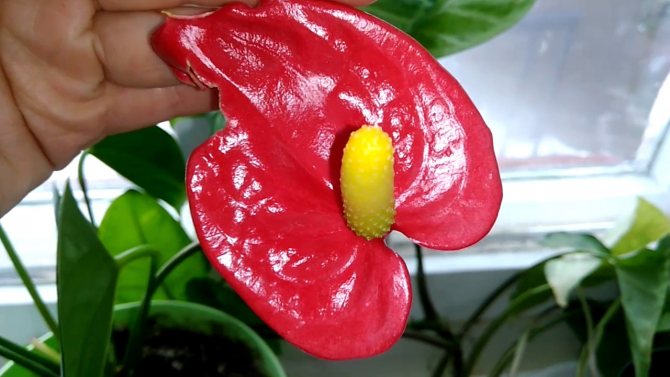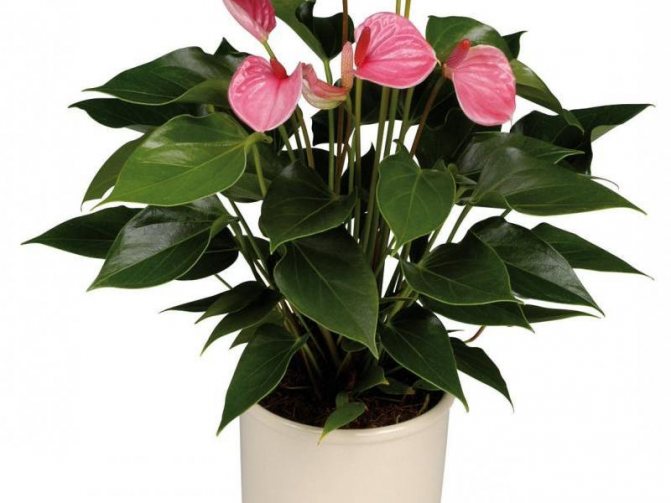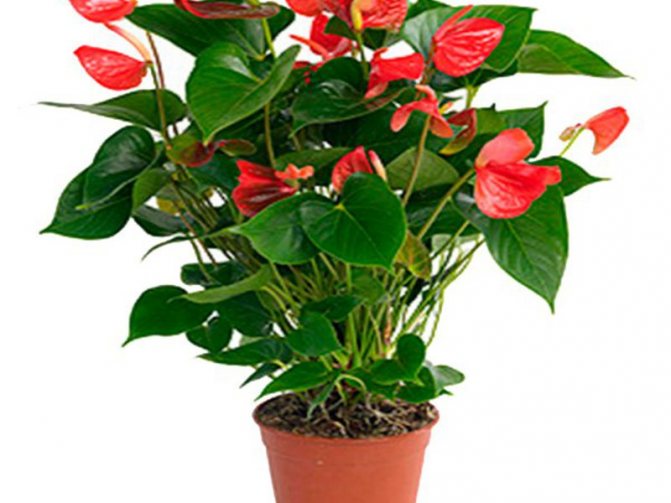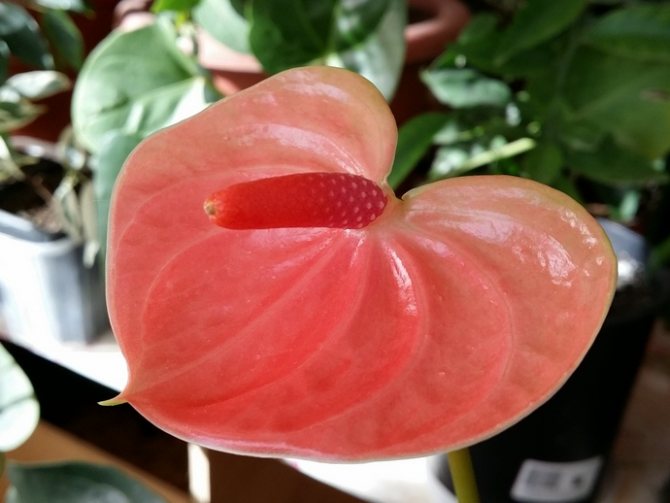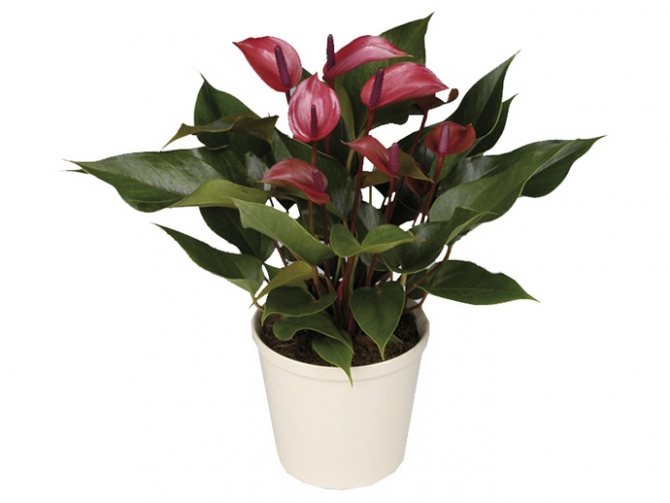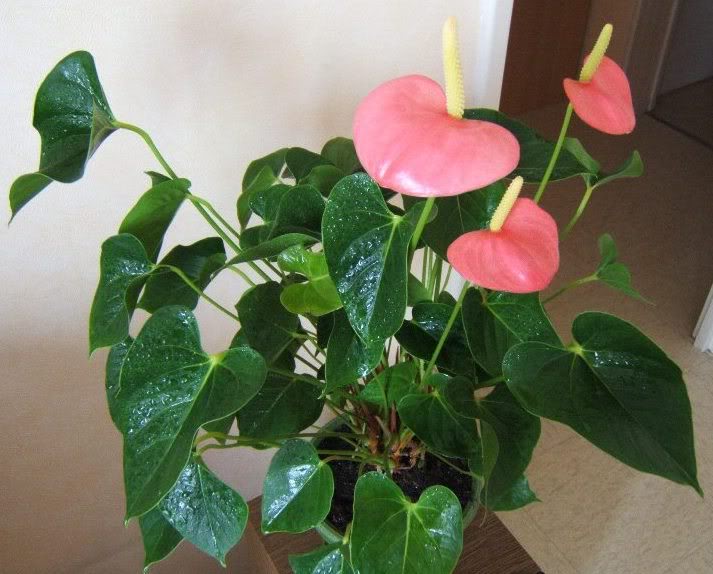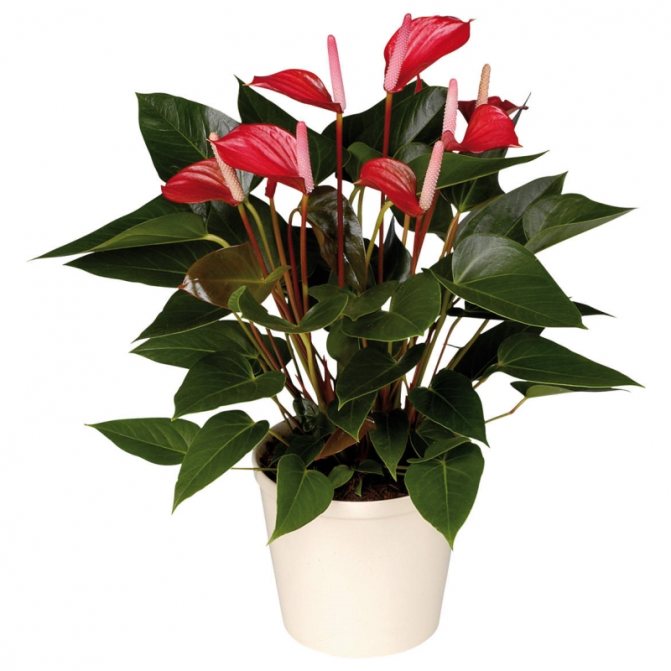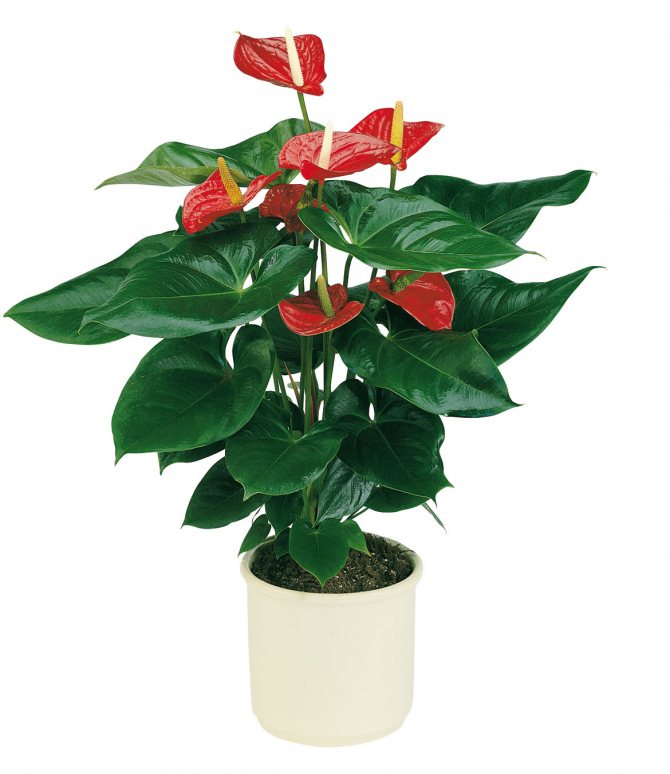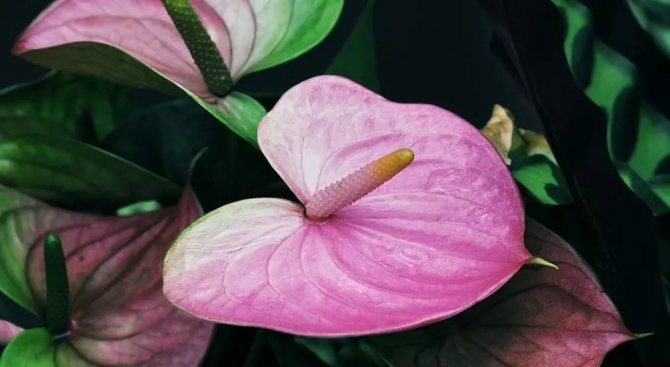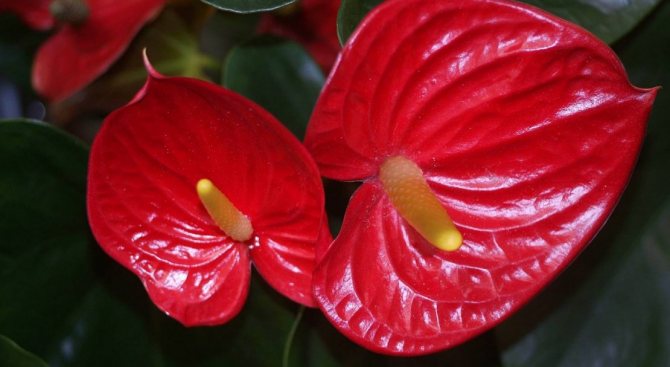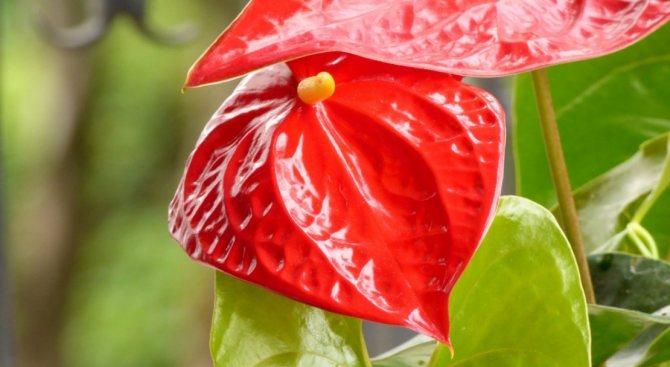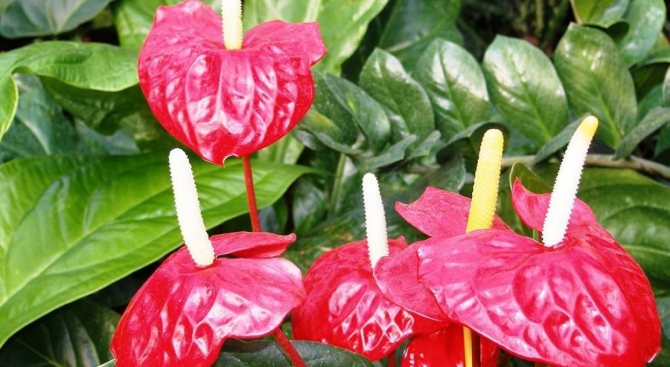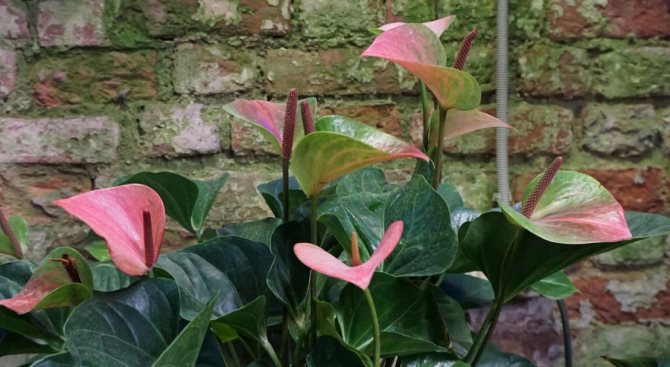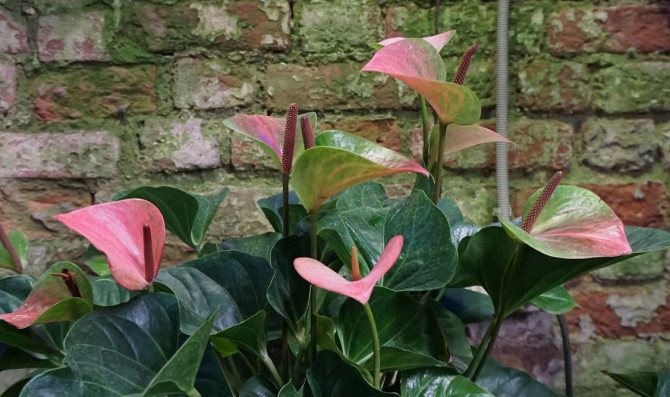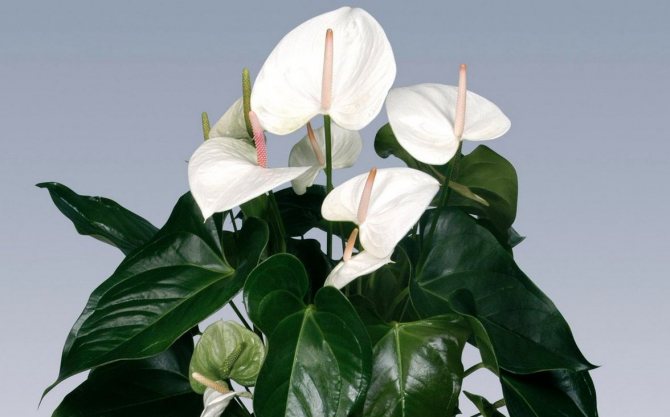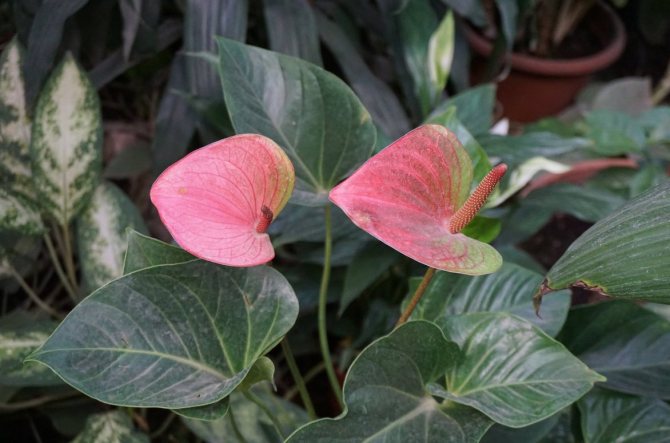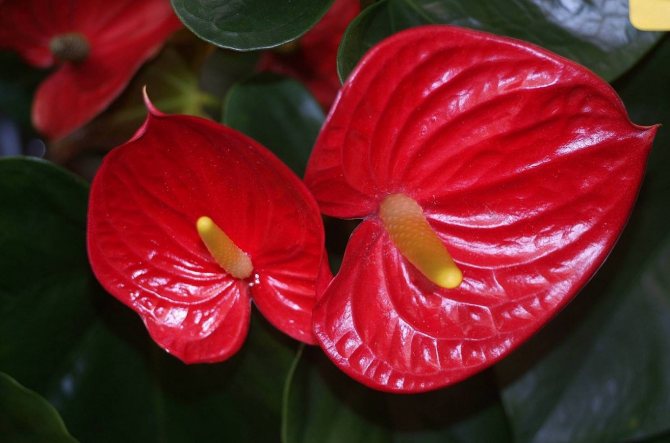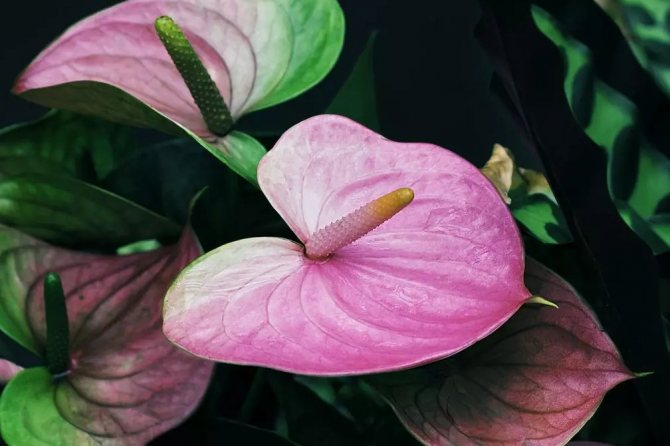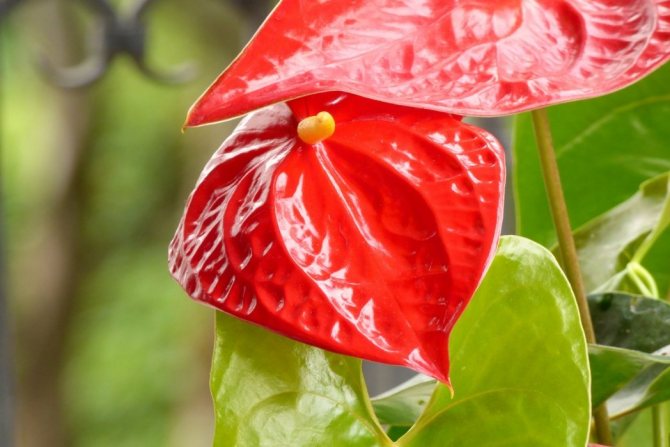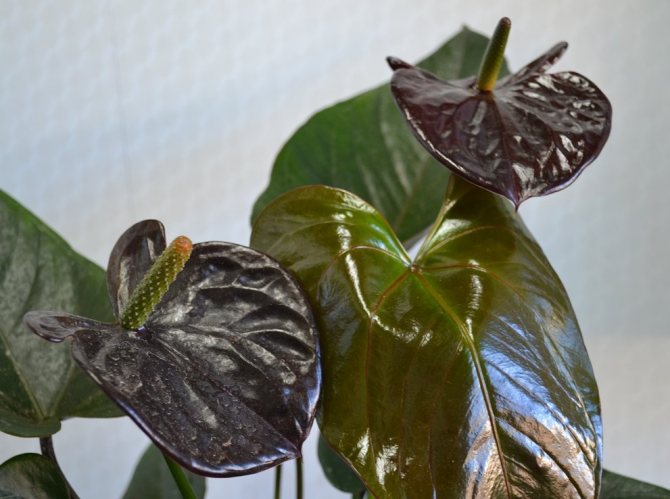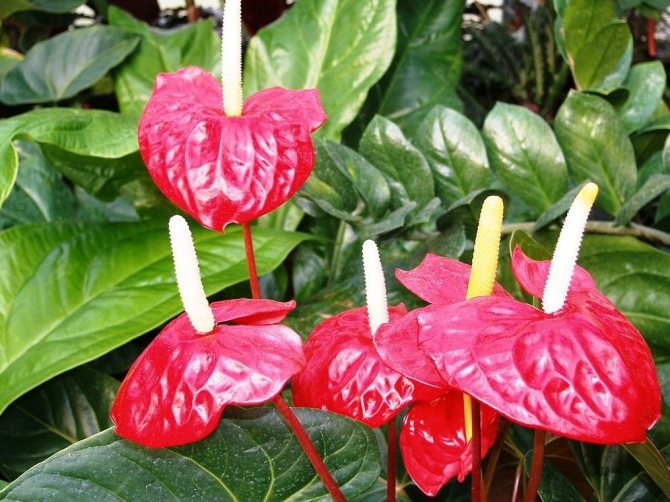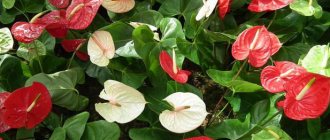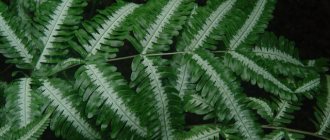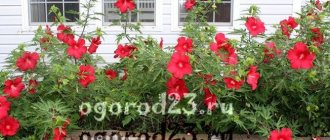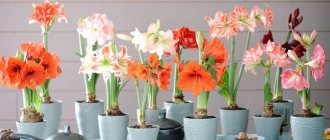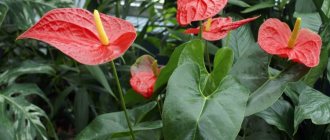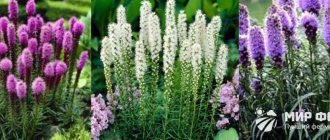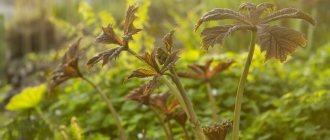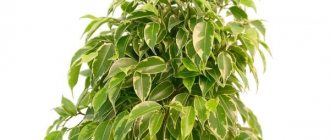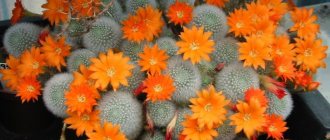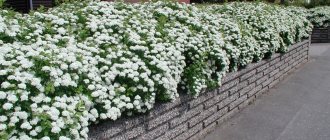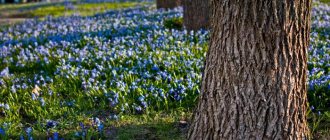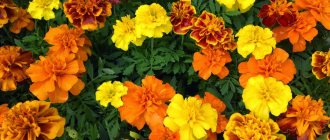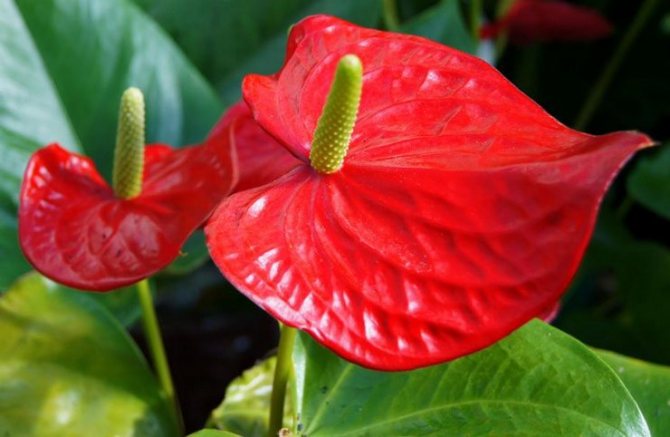
Anthurium Andre (Anthurium andreanum) is an evergreen perennial from the Aroid family, whose homeland is the tropical regions of South America. On the forest soils of Ecuador and Colombia, the epiphyte is distinguished by bright green oval-lanceolate leaves with a shiny surface, almost 30 cm long, on petioles of approximately the same length and a large, inflorescence heart-shaped leaf with a slightly bubbly or wrinkled surface. Its cob inflorescences consist of numerous yellow flowers. After the end of flowering, spherical orange fruits are formed on the plant.
Among the numerous varieties and hybrids, there are specimens that differ in height, flowering duration and color palette. Anthurium Andre can bloom from 1 to 12 months with all the colors of the rainbow and many different shades. Some varieties surprise with their almost black or two-tone color.
Anthurium Andre care at home
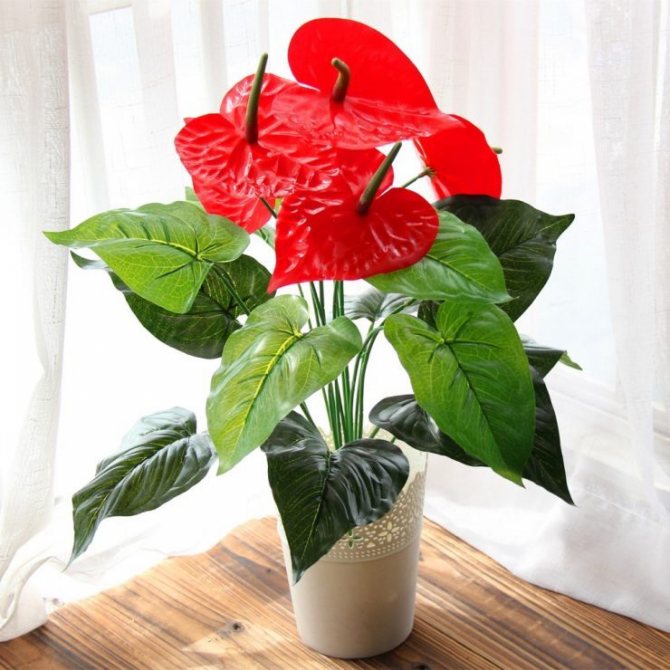

This evergreen flowering culture feels great at home, but, however, subject to certain requirements.
Location and lighting
Anthurium flower Andre does not like direct sunlight. It is recommended to place it on windowsills from the east, north-east, west and north-west sides of the house. The light should be diffused, and the place may be partial shade. In the period from October to February, when there is not enough natural light, you can supplement the illumination of plants with fluorescent lamps or phytolamps.
Temperature
The favorable temperature for growing Andre anthurium in the summer is from 20 to 25 degrees Celsius. Growth can slow down or stop if the temperature drops to 18 degrees. In winter, for 1.5-2 months, anthurium is in a dormant period and prefers to be kept in cool conditions with a temperature of 15-16 degrees. These cool conditions are conducive to bud formation and active flowering in the future.
Watering
Irrigation water for anthurium should be filtered or boiled, you can use tap water, but before watering it is recommended to add a small amount of lemon juice or a few drops of acetic acid to it. Soft, settled water with a temperature of 20-22 degrees is plentifully watered crops throughout the growing season. The next moistening of the soil is carried out only after a slight drying of the upper layer, but no more than 1-2 cm. In winter, the volume and frequency of watering are reduced. Lack and excess of moisture in the soil is equally dangerous for the life of anthurium.
Air humidity
A high level of humidity is necessary for Andre's anthurium throughout the year (even during the dormant period). To maintain it, it is recommended to carry out daily water procedures in the morning and evening hours in the form of spraying with warm water. An additional vessel with water, located next to indoor flowers, or a tray with wet expanded clay also contributes to increased humidity.
The soil
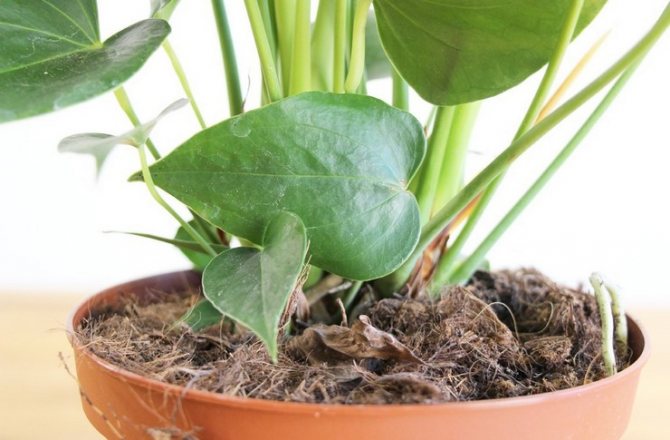

The potting mix must be breathable. This requirement is met by the soil for growing orchids, which can be purchased at a specialized store.When preparing the mixture yourself, it is imperative to take one part of vermiculite and coarse river sand, two parts of crushed pine bark, coniferous, peat and leaf land and a small amount of charcoal.
The flower container should be shallow, but with an obligatory drainage layer (at least 3 cm) and additional holes on the walls.
Top dressing and fertilizers
Nutrient dressings intended for orchids are applied to the soil during the growing season every 15-20 days.
Transfer
In the first 5 years, indoor cultures of Andre anthurium are recommended to be transplanted once a year, and in subsequent years - as needed.
Gallery: anthurium andré (25 photos)
Diseases and pests
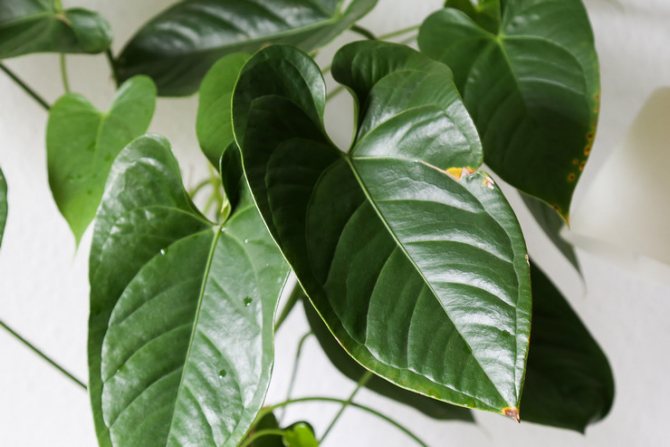

The main pests of anthurium are scale insects and spider mites. Dealing with them is not easy and ineffective. A regular warm shower is an excellent means of preventing harmful insects.
The flower is often sick due to improper care or under improper maintenance conditions. The main diseases are stem rot, root rot, rust, anthracnose, downy mildew.
The most common causes of root and stem rot are low indoor temperatures and regular waterlogging of the soil.
Signs of anthracnose are dry brown tips on the leaves, which lead first to the complete drying of the leaf part, and then to the death of the entire culture. It is very difficult to cure a plant from this ailment, and sometimes it is simply impossible. As a preventive measure, experienced florists recommend regularly spraying with fungicides.
Withering of anthurium often occurs due to contact with an infected indoor flower or poor-quality substrate, as well as with a lack or excess of fertilizers.
Note to flower growers!
The stems and leaves of the plant contain toxic substances that are dangerous to the life and health of people and pets. This should be taken into account when choosing a growing location, especially if there are small children and cats in the apartment.
Why does the plant not bloom, leaves turn yellow?
When growing anthurium, problematic situations often arise associated with non-compliance with basic care requirements.
- The leaf plates dry up - the main reason for the process is the presence of pests or a lack of moisture.
- The leaves turn yellow - the problem may be a consequence of excess soil moisture, as well as a lack of light, which can be dealt with by installing a phytolamp as an artificial light source.
- The tips of the leaf plates turn black. These are the first manifestations that signal an excess of calcium. The fertilizer concentration is halved.
- Spotting on leaf plates is evidence of an excess of moisture, leading to the development of fungal diseases.
- The representative of the tropics does not bloom - the main reason lies in the absence of a dormant period during which buds are laid. Also, the lack of flowers may be due to a lack of nutrients in the substrate and the need to replace it.
Thus, subject to all the necessary requirements, the florist will become the owner of an elegant decoration of his home, which will caress the eye with bright flowers and lush greenery for a long period of time. A little care will allow you to enjoy the microclimate of the tropics without leaving your own home.
Anthurium Andre - home care (video)
Anthurium Andre has many different names and descriptions, but most often it is called "male happiness". Basically, hostesses grow only 3 varieties of the presented species at home. In the world of its varieties, it is simply impossible to count, but we can confidently say that there are exactly about 1000.
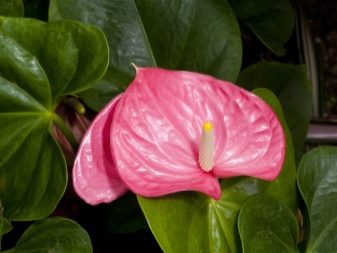

Plant varieties and photos with them
In indoor floriculture, two types are most common - Anthurium Andre and Anthurium Scherzer.For both of them, the red color of the bracts is more typical, but there are a number of white varieties.
Due to its large size, Anthurium Andre is more often grown in greenhouses, but it is also suitable for home conditions. Among the most common varieties are white.
White Champion
White Champion Variety with a yellowish ear on a high peduncle... The snow-white bracts are beautifully curved. Over time, a light green tint breaks through.
White Heart
White Heart The ear of this variety is bright pink with a more intense color closer to the tip, the bract is white, pointed.
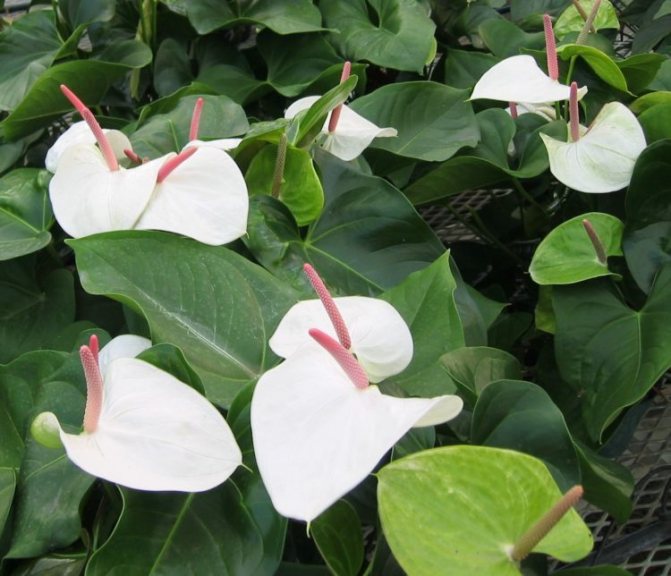

Acropolis
Acropolis (Acropolis). The ear is light yellow at the base, with a bright yellow tip reminiscent of a candle flame. The bract is snow-white, the shape is close to round. This variety is characterized by large leaves..
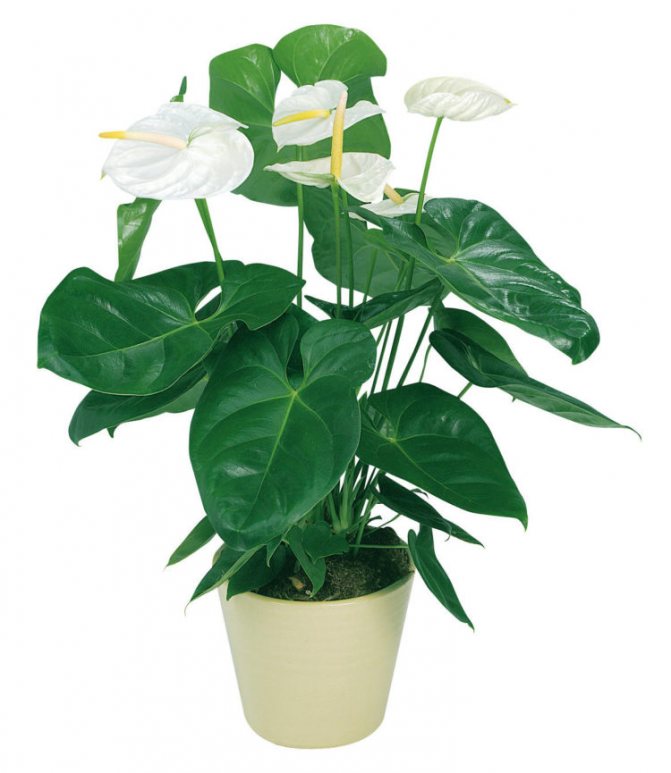

Polaris
Polaris (North Star). The ear is white, with time it acquires a pinkish tint. The bract - elongated, pointed, with beautiful curves - resembles a ray of a star. As it blooms, it becomes greenish.
Scherzer
Scherzer's Anthurium is more suitable for rooms and offices... A distinctive feature is the ear, slightly twisted in a spiral. Among the white varieties, Album with a white ear and a white oval bracts is best known. Scherzer's anthurium varieties are described here.
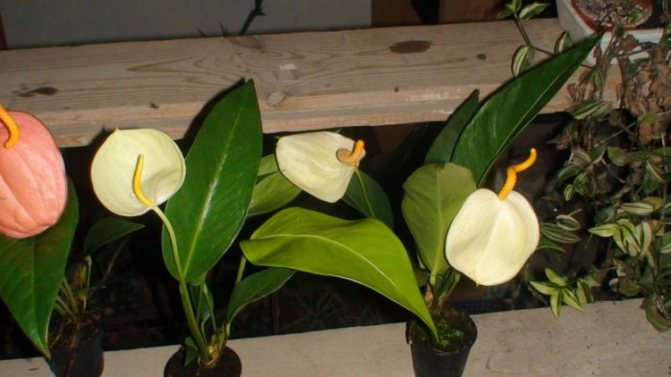

Features of the
This is the most numerous species of the Aroid family. The genus Anthurium includes a wide variety of lianas, evergreens, but most often epiphytes, which actually grow in the tropics. Epiphytes are aerial roots that descend from the branches to the very ground. There are also lithophytes that grow on rocks. Otherwise, it is also called flamingo. It was brought to our country from Central and South America. And what a variety of leaf shapes the presented plant has. These are dissected leaves, and in the shape of a heart, scapula, and also elementary rounded. They can shine with a beautiful gloss or be matte. The plant also has a peculiarity to turn after the sun.
Read also: Is it possible to work tomorrow
The key personality of anthurium is in its abundance of colors. Flowers range in color from white to green, including reds and purples. Indoor plants still have a different ear. It also comes in various forms. In the form of a mace, cone, spiral or ball. And also different in color. Above, the ear covers the catchy leaf of the flower. The flowers themselves are more diamond-shaped and square.
Believe it or not, this flower is still amazing with its own smells. They can be both subtle and bright, even smelly.
Anthurium blooms all year round. The main thing is that the flower has good lighting. Fortunately, special UV lamps have now been invented for this. Flowers keep within 1-2 months. When pollinated, this kind of flowers produces berries with seeds.
Those who grow anthurium at home most likely noted that this kind of flowers has such a feature as aging. But there are methods to "rejuvenate" the plant. Phytodesigners of premises make great money on these colors, since anthurium looks luxurious. They are also used by the masters of drawing up bouquets. And at the same time, the flowers not only look rich, but also have every chance to stand in a vase for a long time.
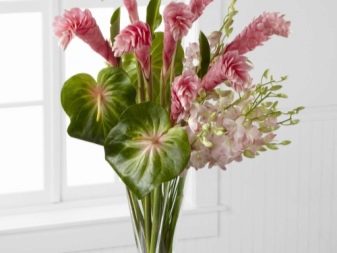

Anturum Andrianum (Andre)
The most popular type of anthurium, which belongs to the group of flowering flowers, is the anthurium Andrianum (from the Latin anthurium Andreanum), it is also the anthurium Andre.
The main advantage of Andre's indoor anthurium is an inflorescence that has an unusual shape. Looking at it, one gets the impression that the flower is not real, but plastic. On a long, thin stem, a red, white, purple or pale pink petal blooms, called a "veil".From the inside of each such blanket, an erect or slightly drooping, white or yellow ear of 8–10 cm in length is pulled out, which, if you look closely, also consists of small flowers. This is the flower of Andre anthurium itself. A glossy bright petal (bedspread) is just a bracts (bracts).
All varieties are approximately similar to each other in structure, but diverse in the shape of the bedspread and its colors. Particularly attractive specimens have bright bracts and beautiful names:
- anthurium Red - Arizona;
- antarium Pink - Pink Champion;
- anthurium White - Chempion, Acropolis, Polaris;
- Anthurium Yellow - Casino, Marasol;
- multicolored anthuriums Andre Mix - Mixed.
Many bushes reach heights of up to a meter, have large glossy leaves, oblong-heart-shaped. The smell from different varieties of Andre's antariums can vary significantly.
Breeders never cease to amaze lovers of aroid plants and periodically replenish classic specimens. This is how new varieties appeared:
- lilac (Sensa);
- salmon (Minnesota);
- purple (Fiorino);
- green (Manaka);
- black (Black Queen) - anthurium Black Queen.
Varieties
Consider some of the most popular varieties of anthurium.
Andreanum
Anthurium Andreanum has rather large greenish heart-shaped leaves. And the plant itself is also large. The stems have a large number of aerial roots. Surfaces in various colors: white, pink, scarlet, yellow and green.
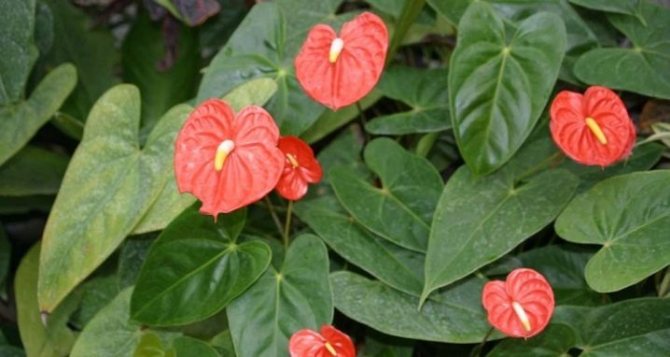

Scherzerianum
Anthurium Scherzerianum belongs to epiphytes. The stems are shortened. It grows no higher than 40 cm. The leaves, like Andre's anthurium, have a leathery structure, but are covered with dark dots on both sides. As a rule, its inflorescences are higher than the plant itself. The surface is scarlet red. Other colors are rare.
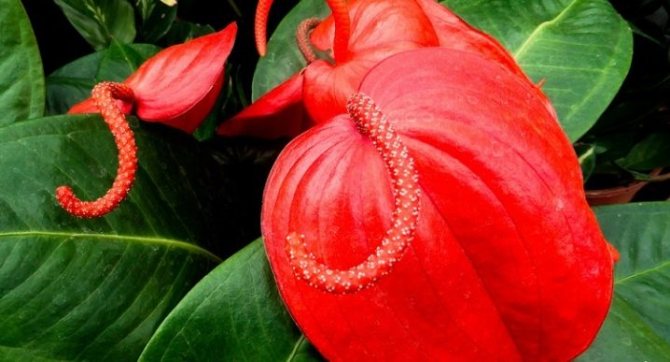

"Andrianum Champion"
Andrianum Champion has large leathery leaves. He has a modified bracts. The bract itself comes in different shades. An inflorescence is located inside it. The ear is slightly curved. Depending on the variety, the color changes from white to black. It can bloom all year round. The flower itself is red. Blooms for about three months. It grows to a maximum of 65 cm.
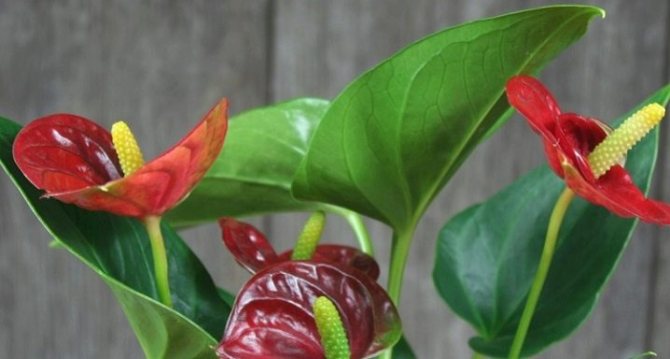

Dakota
Anthurium "Dakota" is very large, reaching a height of 80 cm. The size of the bedspread is up to 20 cm. The ear is yellow.
Anthurium Andre "Baby Boomer"
Anthurium Andre "Baby Boomer" - for it you need a light, slightly acidic soil filled with minerals. It grows up to 90 cm. It blooms for 3 months. At home, it is better to keep it from the west or south side, sometimes you need to expose it to the sun, but not longer than 2 hours. Just like other varieties of anthurium, it needs abundant watering and maintaining high humidity in the room.
When Baby Boomer begins to grow actively, it should be fed regularly.
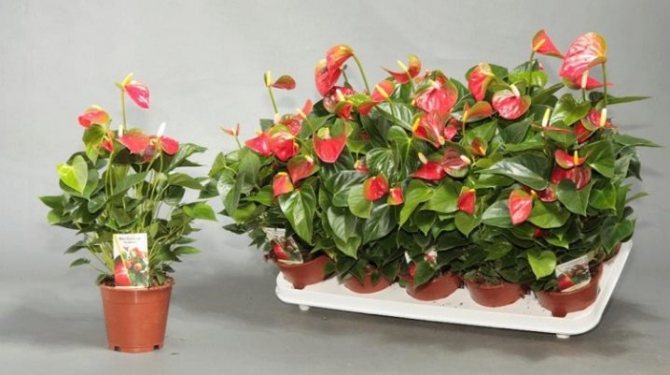

"Sierra"
Anthurium "Sierra" - if most varieties of this family are high enough, then this variety is medium in size and will fit into any interior. The flowers are passionate red, the peduncle is rather large, yellow-green. Most often, it is he who is chosen as a gift, and not only for a woman, but also for a man. If you take proper care of "Sierra", it will delight you with its flowering all year round.
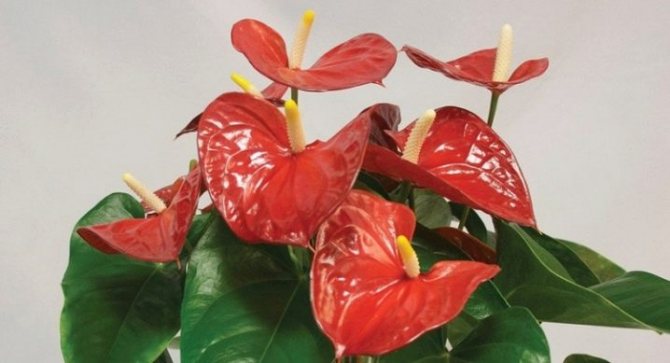

Crysytallinum
Anthurium Crysytallinum - the leaves of this plant with a life span change from yellow-violet to green and do not grow more than 20 cm. Their velvety surface is presented in the form of a heart. On it you can see the silver streaks. This anthurium is called crystal not only because of such veins, but also because of the beautiful purple or green coverlet, which generally resembles this material.
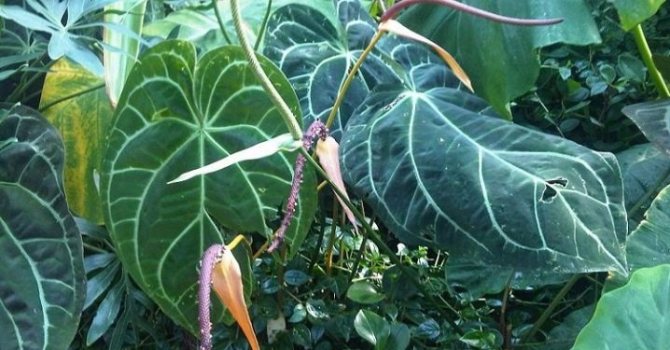

"Great"
Anthurium "Magnificent" is also often found among domestic species. It is somewhat similar to the previous species.It is a beautiful plant with large velvety greenish leaves. The leaves have snow-white veins.
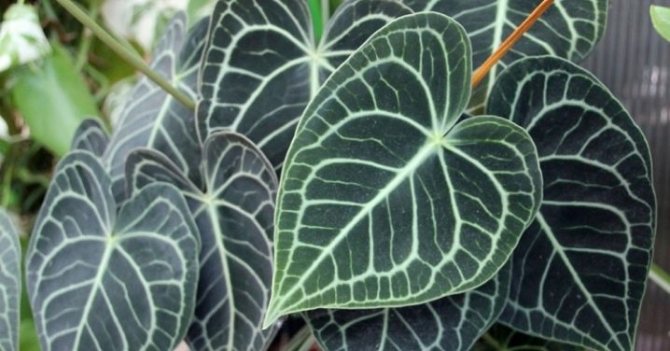

Linden's Anthurium
There is also a rather unusual view of Linden's anthurium. This species is found in the wild. Pink anthurium is rare, more often saturated green. This species is native to Colombia. It grows more often under trees or as an epiphyte on a tree. The key difference between Linden's anthurium is in the shape of its leaves. They have the shape of a pointed heart and shine with gloss. The leaves are quite large. Sometimes their length reaches 30 cm. They also have olive-colored veins. The bract of the plant is pink in color and rounded, pointed to the tip of the leaf. On a peduncle about 40 cm in size is a creamy white ear. When it blooms, it smells bright.
Like the previous species, Linden's anthurium was domesticated by people, but this species is more for the street than for the house.
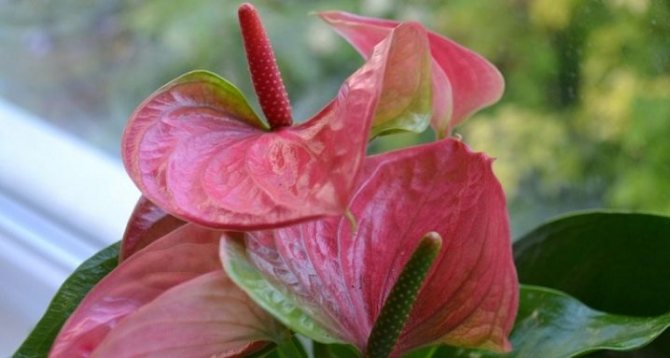

Hooker's Anthurium
Hooker's anthurium can very rarely be found at home, only if somewhere in private collections, since this plant is still wild. Found in the Lesser Antilles, in the rainforests of Suriname, Trinidad and in some parts of Guiana. Rosette leaves. The diameter of one such rosette is quite large, within 150-200 cm and a little more than 50 cm in height. The stem is literally not visible. The leaves are large, elliptical, narrowed. If you look closely, you can see dark spots on the leaves. The leaf petioles are rather short, which also distinguishes this type of plant from the rest. It is quite difficult to grow Hooker's anthurium at home so that its ear can be seen. But if you manage to achieve this, then you will see a large ear of dark purple color within 30 cm high with a bracts, slightly shorter than the inflorescence itself.
Among the most popular varieties, you can also highlight "Mix", "Almera", "Zizu", "Sweetheart pink".
All the most popular types and varieties of flowers: name, description and photo
Check out the names of the varieties of the flamingo flower and their appearance in the photo:
Baby boomer
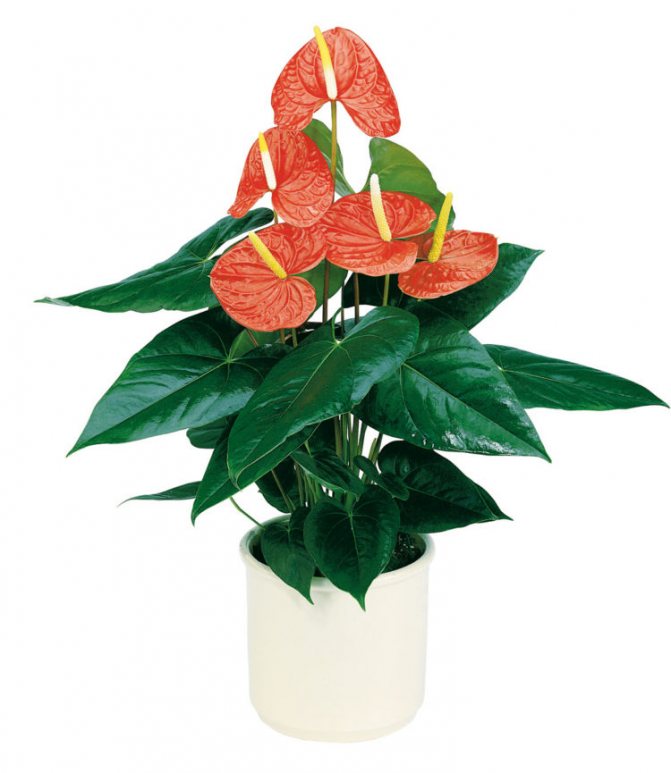

Anthurium andraeanum Baby boomer was first bred in 2006. It stands out for its unpretentious care and rapid development. Grows large: up to 90 centimeters in height. The leaves are wide, shiny, leathery. The ear near the inflorescence can be either curved or erect. Flowers of scarlet shades with white broad strokes. Flowering is profuse and long, from June to late September.
Fiorino
A tulip-veiled cultivar that ranges in color from pale pink to deep purple. The flowers are small, the shape is somewhat unusual for the species - they are elongated and hooked, with dark compact cobs. Quite moody look: requires a lot of sunlight. Do not allow water to enter the blanket, otherwise its color may fade. Observing the conditions of care, the owner can achieve year-round flowering.
Fantasy Love
Fantasy Love is a large variety with variegated buds. When the bedspread is dissolved, white and pink (of different shades) flowers are interspersed (we wrote about varieties with white flowers here). In an adult plant, the white areas turn green. Light needs diffused, partial shade does not tolerate well and begins to fade. Loves high humidity and abundant watering. Blooms all summer, if you follow all the recommendations.
Turenza Perfect Red
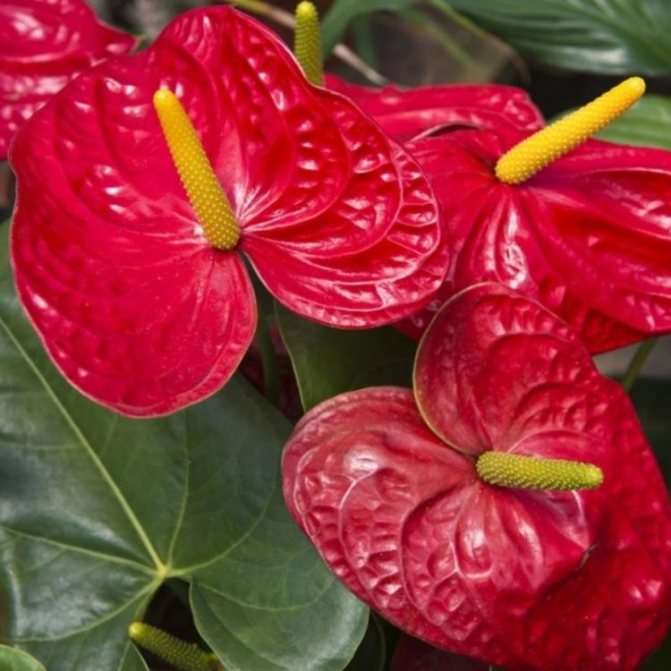

The appearance of the plant is truly mesmerizing. It fits perfectly into any room - residential or office. It has large and glossy leaves with a beautiful structure, and the flowers are bright red in color. To form a beautiful bush, you can plant several stems in one pot. This variety needs frequent and regular spraying., preferably in the morning.
Alabama Pink
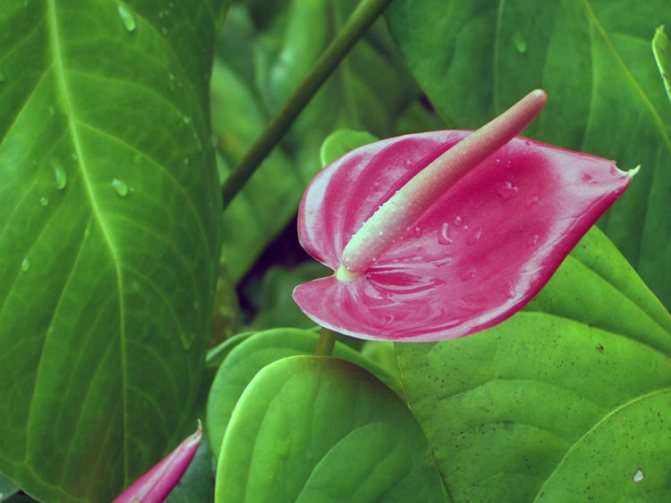

This variety has exceptionally large flowers.and the bedspread is bright pink.The ear-inflorescence is creamy white.
The plant is tall and voluminous, so medium and large pots (14-21 centimeters) are selected for growing. Resistant to low temperatures.
Flowering is profuse for seven and a half weeks.
Blue (Princess Alexia Blue and Picasso Blue)
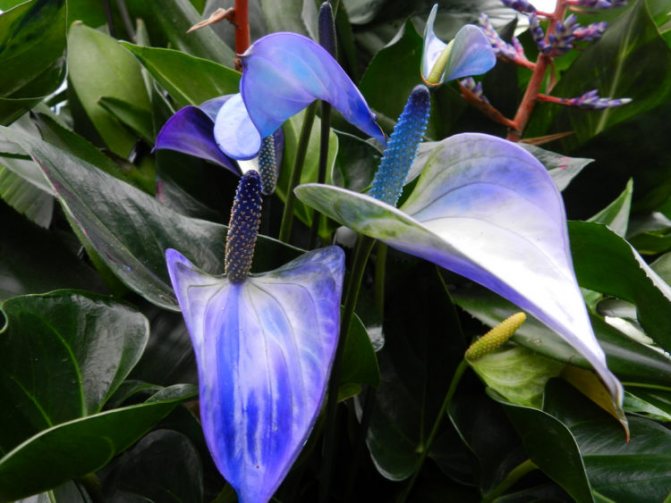

Blue anthuriums include varieties: Princess Alexia and Picasso blue. Botanists are unanimous: Anthurium does not have a blue or blue pigment gene. Therefore, it is simply impossible to bring a variety with a bedspread of this color in a natural way. However, flower producers have found a way out: flowers are painted with special ink, injecting them into the stalk. Thanks to this simple trick, plants with attractive foliage are created, which are used for decorative landscaping of premises.
Chocolate Love
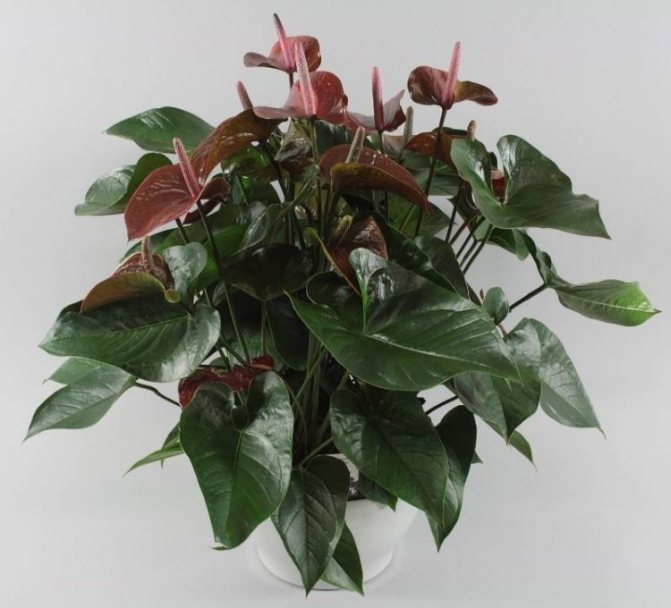

Anthurium Chocolate Love belongs to the group of green-leaved anthuriums... The average height of this decorative-flowering evergreen dwarf shrub is 50 centimeters. It has glossy, leathery leaves on long petioles.
The top side is deep green, the bottom is matte, velvety to the touch. There are no well-defined veins.
The ear is straight, grows straight up and is colored light green. As it blooms, it gradually darkens. Bedspread (bract) - shaped like a heart with a glossy surface. The tip is sharp, the edges are slightly raised. The veins are clearly traced. The size of the bedspread is 9-11 centimeters across. Arrows of peduncles are vertical, rise above the leaves.
By creating favorable conditions for the variety, the owner will receive lush greenery from numerous growth points.
Important! The variety is capricious and easily injured. It requires high humidity in the room, spraying in the morning and enough light.
We have prepared useful information about climbing and crystal anthurium, as well as the variety André.
Vanilla
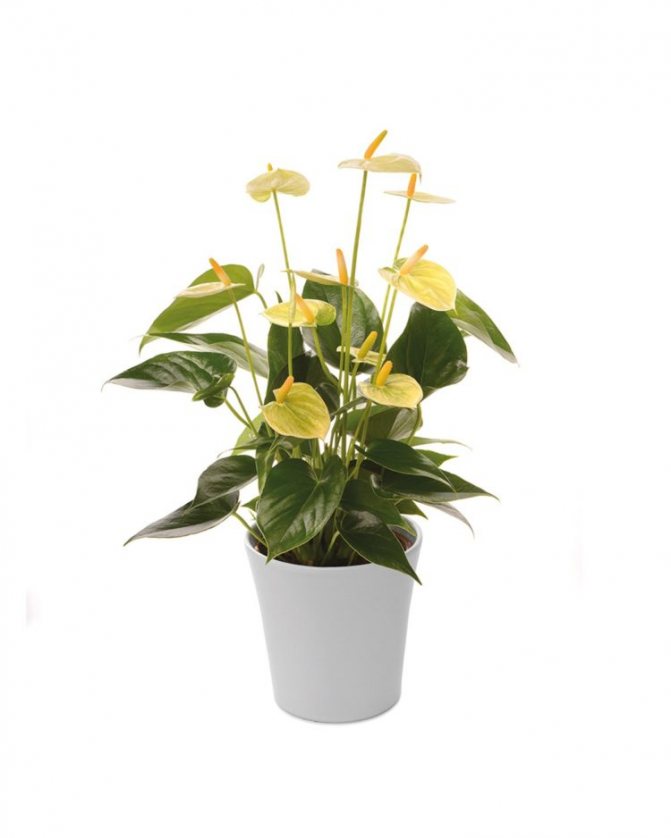

A very beautiful variety, has a unique yellow color of the bracts.
The plant grows medium in size, like the flowers.
Resistant to falling temperatures. The flowering period is 7 weeks.
Leganza
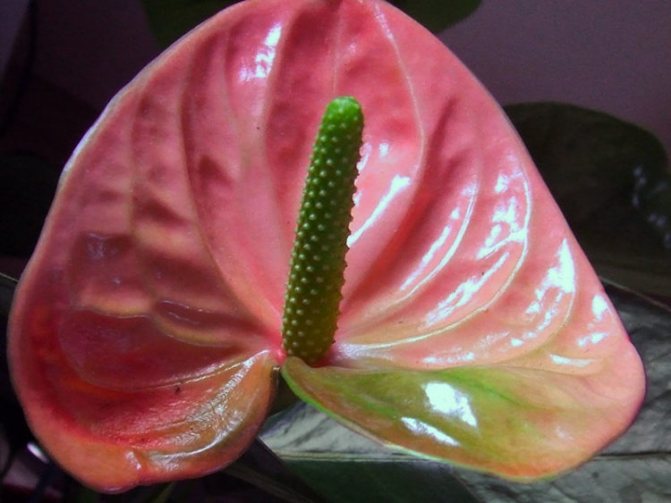

The variety is distinguished by the delicate coloration of the bracts.: pink and soft green, and a spectacular gradient transition. Leaves are oval, with pointed tips. The flowers are bright orange, along the edge of the petals there is an elegant greenish edging (we talked about different varieties of anthurium with orange flowers here). Outwardly, they resemble bumps framed by a bedspread.
Pandola
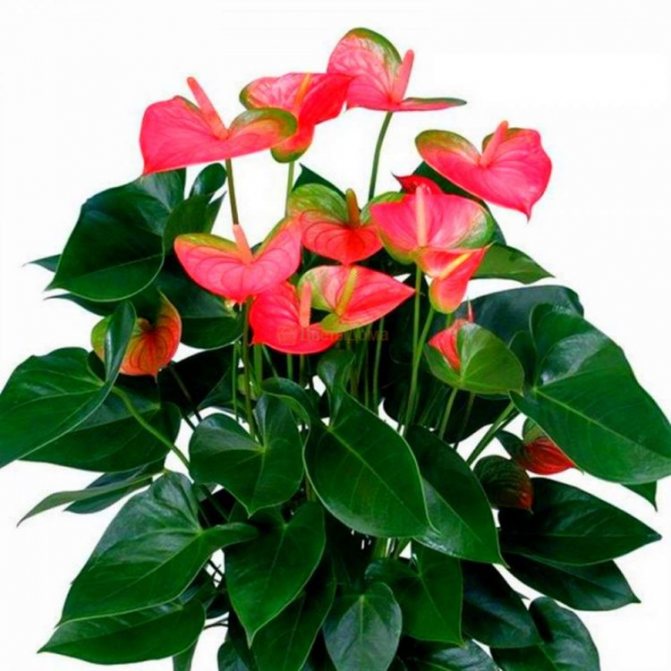

Anthurium Pandola, thanks to the original color of the bracts in the form of an unusual gradient (deep green smoothly turns into pale pink), can be called a real gem among anthuriums. The flowering time is mid-spring, but you can achieve year-round if you take good care of it. Often suffers from fungal diseases and rotting of the bulbs. It is necessary to replant after the end of flowering once a year.
Otazu
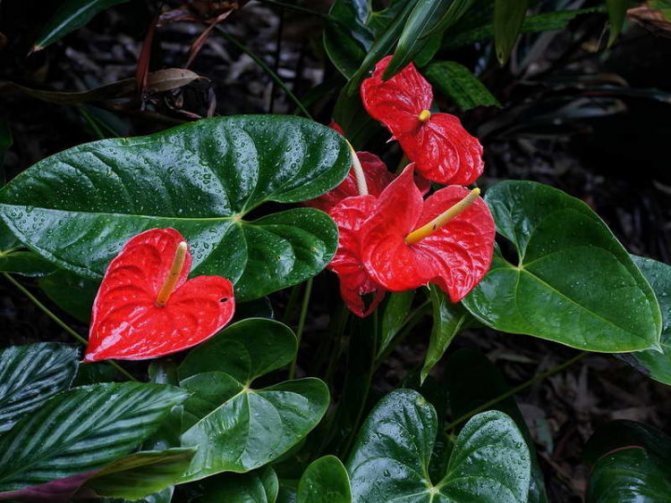

A compact medium-sized variety capable of pleasing its owner with bright flowers for a whole year. The bedspread is dark red, slightly concave. Effectively contrasts with green pointed leaves and yellow inflorescences.
Picasso
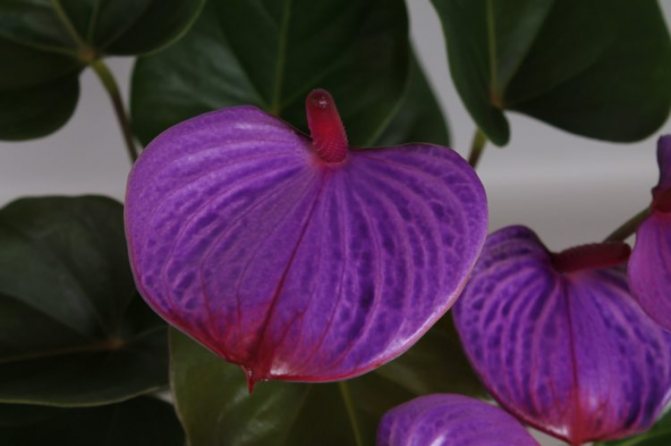

Anthurium andreanum Picasso has a short trunk, oval wide leaves and long petioles with bends, reaching a length of 24-30 cm. It grows well at home. The highlight is the color of the bedspread thickening towards the base and tip., which is why the flower looks especially bright and voluminous.
Princess Alexia Blue
The variety surprises with the color of its bedspread and cob - bright ultramarine (however, during the formation of the bedspread, green tints are noticeable). The size of the inflorescence is also impressive. Scientists have achieved such results by introducing a dye into the root system.
Do not over-water and allow water to stagnate in the pan.Liquid should not get into the pre-flower! Mineral fertilizing is selected. Young plants are transplanted every 2 years, adults - every 3-4 years.
Hot Lips
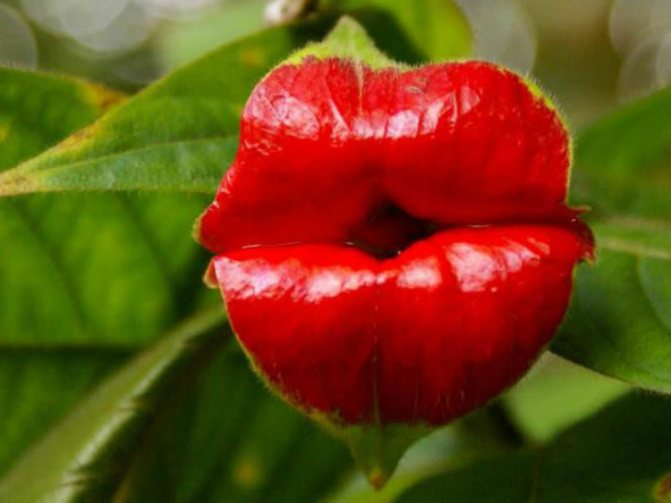

Hot Lips - a medium-sized plant with large leathery leaves and an original flower - a modified bracts. The color can be different. The ear is curved or straight, and may be black or white. It often blooms all year round.
Rainbow Champion
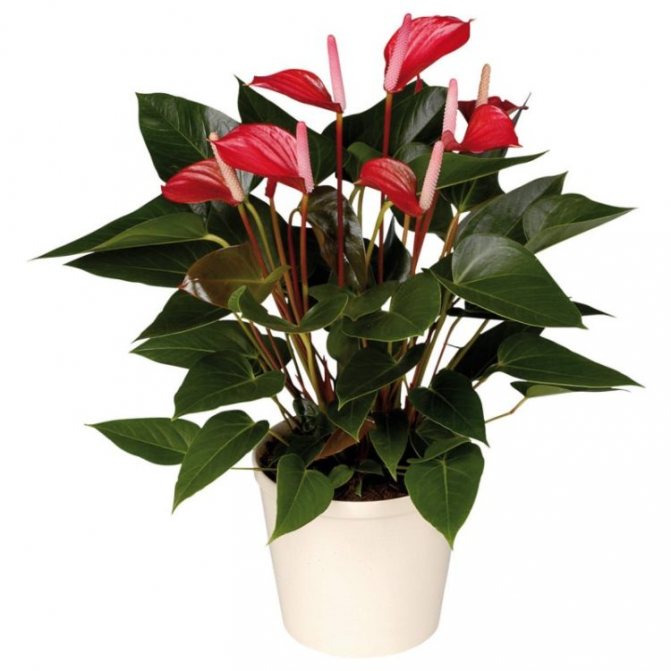

Bicolor miniature variety. Chocolate-colored leaves with a touch of bronze, gradually turn green with age. The bedspread is salmon-orange in color, turns dark brown over time.
Rima Lila
The approximate size of the bush is 70 cm, width is 50 cm. The leaves can resemble arrows or hearts, hard, dark green. The diameter of the flowers is 10-20 centimeters, the inflorescence resembles ear of yellow, pink or white... Blooming all year round. Likes partial shade or diffused bright light, as well as daily spraying.
Belize
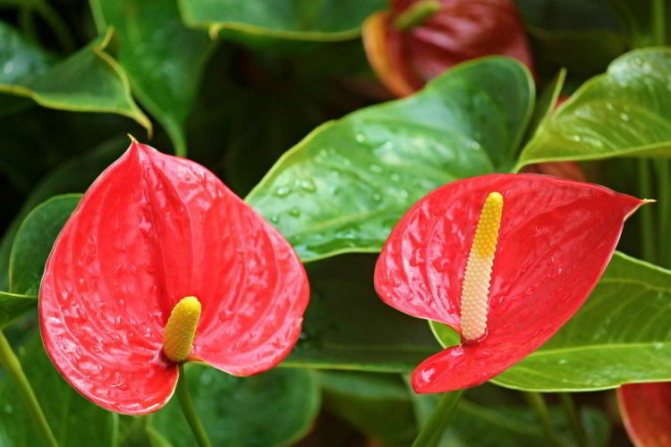

A characteristic feature of the variety is a bright yellow ear. Around which is wrapped a scarlet bedspread with a green frame around the edge. Leaves are cordate, glossy.
Almera
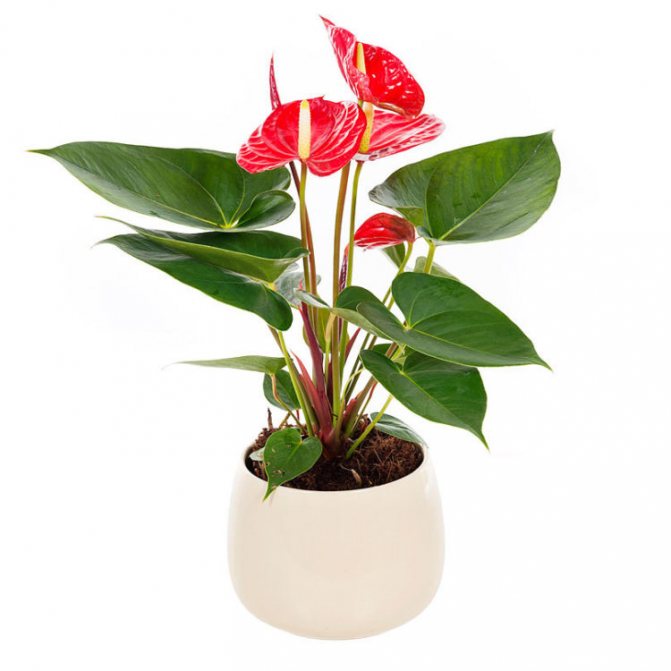

One of the first cultivated varieties, also one of the largest... The color of the bedspread is fiery red. The leaves are leathery, emerald, the vein mesh is barely noticeable.
Success ed (Red Success)
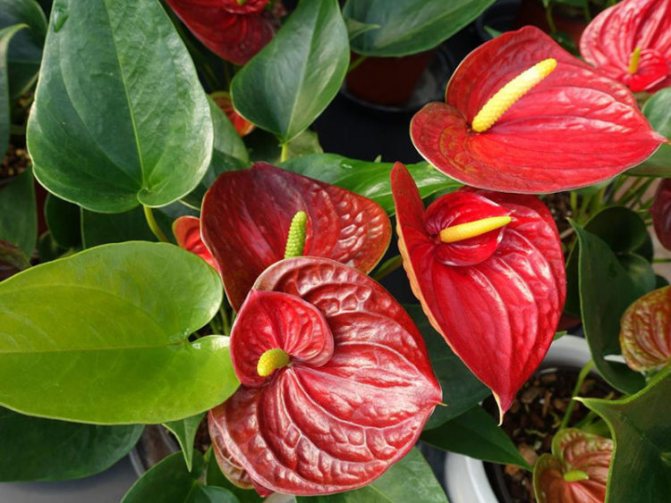

The second name of the variety is "fiery tongue". Its bracts are fiery red, almost crimson, however, the tone of the bedspread may differ in the degree of saturation (depending on the conditions of detention). The leaf plates are large, rounded, the veins are clearly visible.
Green Queen
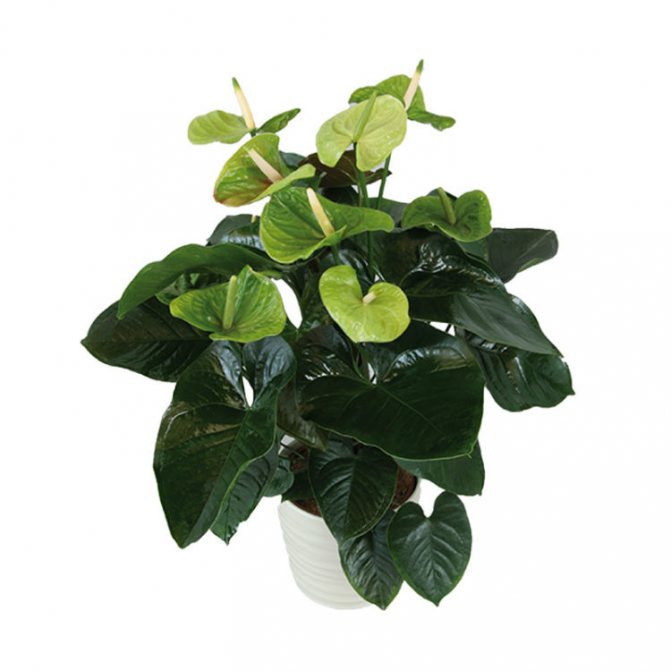

The Green Queen flower resembles a neat ear of beige, white or pink. It is surrounded by a plate resembling a stylized heart shape. Its color ranges from milky white to deep red and pale green. Flowering lasts from March to November. The variety loves spraying and frequent feeding..
Sierra Magic
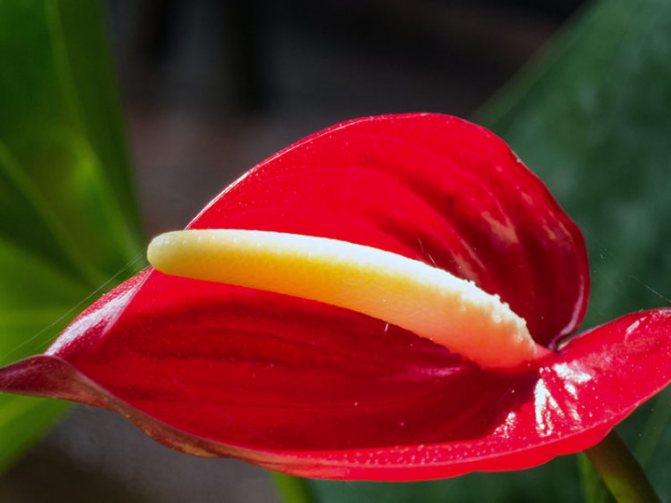

It grows as a lush, medium-sized bush. It has bright red flowers and yellow (rarely green) ears. Blooms all year round.
Sweet Dream
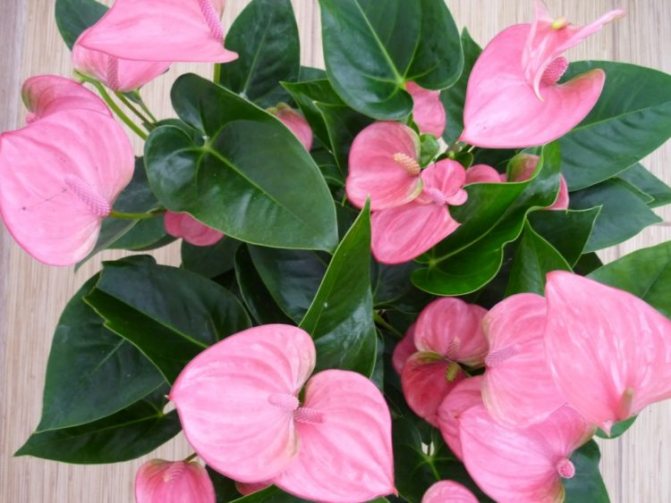

Growers advise growing Sweet Dream in small to medium pots (7-17 cm in diameter). The bracts are bright pink in color and have shiny dark green leaves. Resistant to both high and low temperatures, unpretentious in care. It blooms for an average of 8-9 weeks.
Variegated
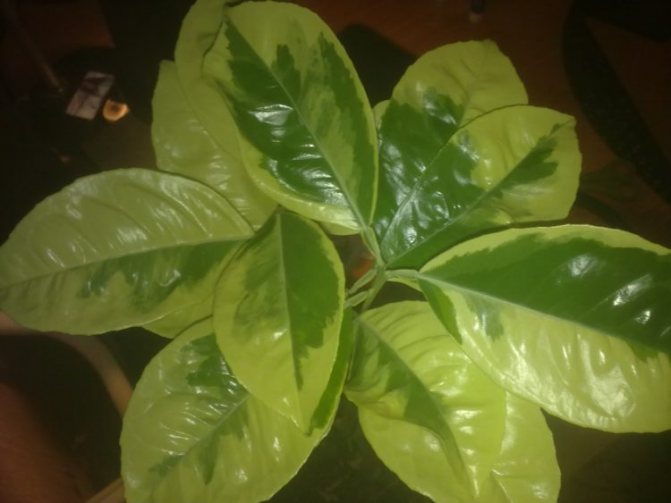

Variation - the presence of mutant cells in a plant with an altered genetic composition... This is reflected in the appearance: clearly delineated areas of a different, lighter color appear on the leaves and stems. In anthurium, such spots can be both in the form of rings and irregular blots, located in different parts of the leaf.
Mix
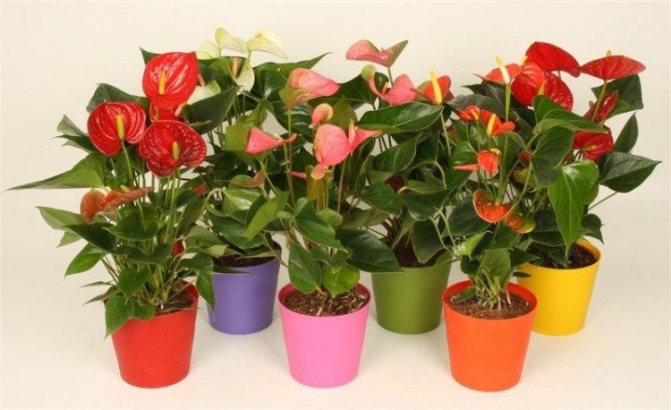

What is Anthurium Mix? A flower is a mixture of varieties of one or more species. By crossing hybrids get a color variety of different shades: from white to burgundy.
Flower lovers may find interesting articles about anthuriums Black Queen (Black Prince), Anthurium Black, Princess Amalia Elegance, Cavalli, Dakota, Hooker, Scherzer (and about Scherzer varieties), Utah.
Conditions of detention
Lighting
If you want your anthurium to grow and bloom perfectly, then it needs a lot of light, but it can grow in the shade, but it has the ability to get sick there. Also, please, so that there is no direct sun exposure. It is better to place it on the west and east side.
Read also: Apricot seeds useful properties
Temperature
Never place the anthurium where it can be blown out and where it will be hot. In winter, the temperature should not be lower than 16 degrees. In summer it can reach 28 degrees.


Air humidity
Anthurium prefers humidity. As a consequence, pat about it in all ways known to you.You can spray the area around or purchase a humidifier. But you should not spray the plant directly, as this will ruin its appearance. It is better to remove dust from leaves with a damp sponge.
Proper lighting is the key to successful growth of anthurium
The key to the successful growth and flowering of Andre anthurium is its location: it is important for the plant to provide diffused light or light partial shade; the east, west and north windows are most suitable. The lack of illumination should be compensated artificially using phytolamps.
The most comfortable temperature for Andre anthurium is 22-25 ° C, at + 18 ° C and below the flower stops growing. In winter, it is recommended to keep anthurium in a cool place, avoiding placing it near heating devices.
Transfer
- Anthurium should be replanted once a year, adding fresh soil. After 5 years, when the plant becomes an adult, you can replant it once every 3 years.
- Do not transplant a plant with diseased roots. Such roots must be removed and treated with crushed coal.
- To prevent the roots from starting to rot, be sure to make sure that there is a drainage layer in the pot.
- The lateral processes are either transplanted into a separate pot, or simply removed.
- The pot is worth choosing depending on your goals. If you intend to propagate anthurium, then you should take a wide pot. And if for you it is necessary to initiate flowering, then in accordance with this it is better to take a much smaller pot.
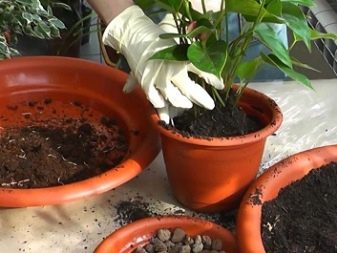

Planting, transplanting and feeding
In order to grow white anthurium, you need to prepare a sufficiently loose, slightly acidic and moisture-permeable soil, which contains peat, deciduous soil, sphagnum moss. The best option is to purchase ready-made soil for growing orchids. By the way, the anthurium flower grows well in hydroponics, moreover, he likes it.
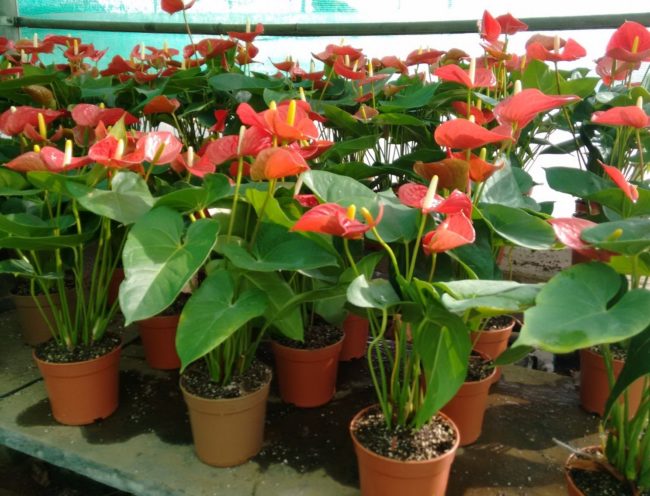

When starting a transplant, you should take a pot that is not very large in size, and lay a drainage layer on its bottom. The flowerpot can stand in a shallow pallet.
Before transplanting, it is necessary to consider the following: an adult plant needs to change the pot if necessary (when it becomes too crowded), younger anthuriums are transplanted annually.
Fertilize the plant in spring and summer twice a month, at the end of August the top dressing is completed. It is good to alternate mineral and organic fertilizers, however, you can use various mixtures designed for orchids.
In autumn and winter, when the dormant period lasts, this flower is not fed at all. However, it is also not worthwhile to abruptly stop feeding in late summer or early autumn, since the active development of young foliage and the subsequent laying of future flower buds require replenishing the loss of their nutrients from the ground.
How to care?
Watering
Despite the fact that these plants love water, it is very important not to overdo it with watering. You need to water abundantly, but carefully. Make sure that the top layer of the earth is dry. If your house is cool, then you don't need to water it too often.
The soil
You can use ready-made soil, which is sold in specialized stores. But you can also do it yourself. You will need a light earthen mixture to which it is desirable to add sand and charcoal. This will allow the plant to breathe and prevent rotting.
Top dressing
In any flower shop you can buy special mineral dressings for this particular family. You need to feed more often - about twice a week. In winter and autumn, anthurium is not fed.
Sometimes, along with watering, you can do foliar dressing.
Beautiful legend about the anthurium flower
An interesting story of the origin of this beautiful flower, which allegedly turned into a young beautiful girl.This story took place in ancient times, when people existed in tribes, at the head of one of which was a cruel bloodthirsty leader. He planned to marry a 15-year-old girl - a resident of a neighboring tribe. But the imperious ruler did not come to the liking of the young beauty, and she refused him. In order to take revenge, the leader attacked the village where the girl lived and took her by force. The bride could not come to terms with life without loved ones and relatives, with a cruel ruler, and threw herself into the fire, lit in honor of the wedding. Before she had time to touch the fire, the merciful gods turned the unfortunate creature into a graceful red anthurium flower, and the village into a tropical impenetrable forest. Colombian residents believe that it is the red anthurium that brings prosperity and happiness to the family, therefore, married couples decorate their homes with these flowers and keep them in wedding chambers for a month. Therefore, the anthurium is rightfully considered the symbol of the honeymoon.
The photo of flowers conveys the variety of varieties of this beautiful and demanded plant.
Reproduction
You can divide a large plant or propagate it by shoots. Also, sometimes a small part of the plant is removed and rooted. And as an option, you can propagate by seeds. If you need the plant to grow quickly and begin to bloom in a short time, use the vegetative method. This will give you an exact copy of the original. This condition is very important for those who wish to receive a copy of the hybrid. Since you need to transplant once every 2-3 years, then during this time from the main bush you can plant at least 2 independent plants, a maximum of five. These measures help the anthurium to grow and bloom better.
Reproduction and disease
Anthuriums are propagated by separating the emerging basal shoots or a lateral shoot, which has independent roots. The latter can be planted as a completely independent plant. The method of grafting is also used, for this they do not divide small segments (about 10 centimeters) of the stems.
The cuttings should be leafy and with at least small air roots. All sections should be carefully processed. In anthurium, you can also root the very tops of the stems, they are cut off if the plant is slightly deformed.
As for diseases, anthuriums are highly susceptible to infectious infections, so if there are problems with a plant in the room, you must immediately isolate it. For example, anthuriums can become infected with anthracnose, the leaves of a plant begin to dry out and without outside help it can die. Also, diseases can occur due to poor care: improper watering, low or excessive illumination, inappropriate temperature conditions.
White anthurium fits perfectly into modern styles of interiors (Scandinavian style, eco - style), as well as interiors of traditional classical style. With proper care, it will decorate your home for a long time.
Diseases and pests
Such problems can be distinguished.
- Leaves turn yellow - the cause of such a disease can be elementary "old age", a large abundance of light, or, conversely, you need to expose the plant to the sun for several hours to heal it.
- Desiccation - frequent airing of the room and low temperatures can lead to it, perhaps you have not watered the plant for a long time.
- The appearance of spots - frostbite or burns. If at the same time growth slows down, then the reason may be in pests. It is also likely that you have overdone the fertilizer.
- If your plant tips dry, then you should think about humidifying the room, or the flower does not have enough oxygen.
- The flower dries - aging (in this case, the fetus usually appears). You can water the plant and try to humidify the air. Perhaps you put the flower in the sun and overexposed it.
- If the leaves of the plant began to turn black, then this is a clear sign that you have overdone it with a supplement that contains calcium.
- The flowers turn black - when you are watering, do not touch the inflorescences. This is what can cause blackening.
- Leaves curl - most likely, your flower has suffered from a sharp change in temperature or is in the shade, and possibly the opposite - the flower needs to be in the sun. You can also try humidifying the indoor air.
- Withering foliage - the roots of the plant must have begun to rot.
- Smallpox - try raising the room temperature. Also, the reason could be a lack of feeding and damage to the roots.
- Enaties - it is necessary that the temperature and humidity are constant.
- Stem rot - high humidity of soil and air.
- Aphid - onion and garlic infusions cope well with these pests. But you can also buy special products in the store: "Fitoverm", "Aktellik", "Karate", "Intavir", "Decis".
- Shields - here "Konfidora", "Bankola", "Biotlin" will help you from store funds.
- Spider mite - "Aktellik", "Flumite", "Oberon", "Akarin", "Omite" will come to the rescue.
- Thrips - from such pests, special Velcro is sold, which attracts them, like a magnet, and various preparations: Fitoverm, Karate, Molniya, Aktellik, Intavir.
- Whiteflies - “Fufanon”, “Biotlin”, “Tanrek”, “Iskra”, “Zubr” will help to cope with them.
- Leaves become small, growth stops - feed your plant.
Summing up, we can say that anthurium is a very capricious plant and requires a lot of attention and care. It is also not cheap. So it is better to purchase it if you have enough time to care for the flower. Otherwise, you will spend a considerable amount, and you will also be upset that the plant died due to the wrong attitude towards it.
Anthurium will suit true gardeners, a beginner is unlikely to cope with it.
In the next video, you will find the rules for the care and watering of Andre "Dakota" anthurium.
The birthplace of anthuriums in the tropics of South and Central America. Despite this, the plants are grown as indoor plants. At home, representatives of the Andre species feel best. They are quite easy to care for and very varied in color. For example, the Champion variety has two color options for bedspreads. The flower multiplies easily, tolerates transplantation well.
Read also: Mass and individual selection
Anthurium andre: description and care instructions
Anthurium Andre, which in Latin is called Anthurium Andrianum, belongs to the Aroid or Aronnikov family. In natural conditions, it can be found in the tropics of Ecuador, as well as Colombia. In nature, the plant leads the lifestyle of an epiphyte. There are even known species that grow in rock crevices.
In the genus of this flower, experts have about 900 species. Popularly, this culture is often called "wax flower" or "flamingo flower". And the very name anthurium owes its origin to the Greek words "tail" and "flower". A beautiful ancient legend is associated with this plant.
Video "Ways of keeping an antrium at home"
Experienced growers talk about the secrets of growing a houseplant.
Legend
It says that in ancient times, when people lived in tribes, one girl turned into a red anthurium. The cruel leader of one tribe liked a beautiful woman from a neighboring one. He attacked the village and took her away. According to tradition, on the day of the wedding celebration, it was customary to make a fire, into which the young beauty rushed, not resigned to her share. The gods took pity on the unfortunate girl, turning her into a luxurious red Anthurium Andre. And the bride's home village has become a beautiful rainforest.
Since then, drops of moisture have flowed down the foliage and grasses in it. They have become a symbol of the tears of inconsolable parents who mourn their daughter. Bright red anthurium is considered a symbol of love and has been growing since those times in the dense greenery of the tropics.Colombians believe that a flower can bring prosperity and happiness. It is with them that married couples decorate their homes on their honeymoon.
Description
Externally, Anthurium Andre is an evergreen and perennial shrub. It has a short stem, green elongated leaves with a shiny surface. Their standard length is 30, width - 12 cm. The peculiarity of the leaf is called its heart-shaped center. The petioles grow up to 30 cm. The ear, in which flowers are collected of a pale yellow shade, can reach a length of about 10 cm. The highlight of the image is the sheet-cover located near the inflorescence. It is wide and somewhat wrinkled, with a heart-shaped shape and distinct veins on the surface.
Anthurium Andre has orange and round fruits. Today, breeders have managed to breed many of its varieties. Each of which has a flowering duration from 1 month to a year, the color of the inflorescence leaf is green, purple, red, burgundy, brown, black or two-color. With proper home care, the plant can exist for 3-4 years, after which it rejuvenates.
Popular varieties of Andre Anthurium are Champion - a plant with yellowish-pink inflorescences and a snow-white veil on which pink veins are visualized; Lentini Pink - a culture with a bedspread colored greenish pink; Otazu - a plant with a veil of maroon tone; Leganza - with a greenish-pink veil. Varieties of Red Anthurium are Dakota varieties - a plant with a veil length of about 25 cm; Black Queen - a culture with a characteristic veil color, having a light-colored inflorescence; Fantasy Love - with a three-color bedspread combining pink, white and green; Cavalli - with a soft purple veil; Fiorino - a plant with a purple-pink shade of bedspread; Utah - Representatives of the Utah variety have an unusual bright pink bedspread.
Care
Anthurium Andre is called the most acceptable of all members of the family for growing at home. One of the conditions for proper care of it is high humidity, which will allow the plant to create an environment similar to its natural one. When caring for your pet at home, take care of the safety of your hands. Wear rubber gloves and wash them well after the procedure. Since the sap of the plant is poisonous, keep children and pets away from it so that they do not get allergic reactions and other troubles.
The comprehensive care that Anthurium Andre needs includes choosing a place for a pet - place it on any side except the south, and shade it a little, and setting the temperature regime - in summer it should be 22 - 25 degrees Celsius, in winter - from 16 to 18 Also, the flower needs abundant watering with boiled water, humidity at the level of 85 - 95% all year round. During the period of intensive growth, complex fertilizing intended for flowering crops should be applied once every 2 weeks. Let us dwell in more detail on such stages of care as the selection of lighting and watering.
Lighting
Anthurium, with proper care, is placed so that bright light falls on it, but the lighting is diffused. It is not recommended to keep the tenant on a windowsill that faces the north side. From the southern one, it is permissible to put the pot on a special stand for flowers deep into the room and opposite the window. It is also advised to shade the glass if the option of placing the plant directly on the window is chosen. The best sides for living and caring for anthurium are called the east and west. It is unacceptable to place a flower in an overly darkened place or so that the scorching rays of the sun fall on it.
Watering
In the warm season, when taking care at home, Anthurium Andre is watered about 2 times a week - as the top layer dries. In winter, watering is required once a week.Remember to remove excess liquid from the pan. The flower is capricious in terms of water quality. Soft and settled is unlikely to suit him, so it is better to use boiled or acidified with acetic or citric acid.
To provide up to 95% humidity when caring for a pet, flower growers use various methods - from daily spraying twice a day and installing a container of water or a tray with wet filler, to radical ones, such as placing a humidifier nearby.
Anthurium at home responds well to rubbing foliage with a damp cloth or sponge, as well as bathing in the shower. The last procedure will additionally moisten air roots, leaves, remove dust and pests from the surface.
Transplant and reproduction
The plant needs light soil with normal aeration. To prepare the substrate, you need to take 1 part of vermiculite and the same amount of coarse sand, 2 parts of crushed pine bark, coniferous, leaf and peat soil. In order to improve the quality of the mixture, it is customary to add some charcoal and coconut fiber. Sphagnum moss is placed on top of such a substrate.
Young crops are transplanted annually, adults need it as the pot fills with the root system. You do not need to take a too large new pot - its parameters should be related to the size of the flower. A flowerpot with large drainage holes is required, at the bottom of which high-quality drainage is placed. When transplanting, try not to damage the roots. It is better to place the base of the bush 5 cm higher above the edge of the container. Sphagnum moss should be wrapped around the air roots.
It is not recommended to replant the plant immediately after purchase. It is only permissible to remove it from the pot and examine the roots. If they are healthy - return to their place, if damaged - set aside for a while from other flowers. After a couple of weeks of adaptation, the anthurium can be transplanted into a fresh substrate.
Reproduction is carried out by cuttings, dividing rhizomes, leaves, seeds, lateral processes. When grafting, the upper part of the stem is cut and rooted in a separate container. The pot is filled with an earthen mixture or peat. When dividing the rhizomes, a large specimen is divided into a couple of parts using a sharp, sterilized knife. The sections are sprinkled with charcoal powder. Each part should have its own roots and a couple of stems.
When propagating by a leaf, a piece of the stem is placed in the substrate together with a leaf and an aerial root. For the subsequent collection of seeds, it is required to pollinate the inflorescences in the first days of flowering. To do this, run on the cob with a cotton swab or brush. Fruit ripening occurs after 9 months or a year. Having pressed the seeds into the ground, for their normal growth, they create a temperature regime of 25 degrees Celsius, provide air flow and sufficient lighting. Next, 3 picks are carried out, the last of which is made not in a small container, but in a normal-sized pot. Seedlings will be visible after 2 months, and plants will begin to bloom in three years.
When propagating by lateral processes, young bushes should be separated and planted. It is possible to rejuvenate a mature culture if you cut off the top with a pair of aerial roots and place it in a separate container.
Disease and pest control
Florists sometimes face such troubles as the appearance of black spots on the flowers - the reason is the ingress of moisture on them; curling foliage - as a result of excessive lighting; rotting stems, fungi - a lot of water when watering; small leaves and lack of flowers - lack of light or dressing. Plants are capable of attacking pests such as mealybugs, aphids, spider mites, and root nematodes. The fight is carried out using insecticides or alternative methods.
The first aid in detecting parasites is considered to be bathing a flower in the shower using laundry soap.If your pet refuses to bloom with the arrival of spring, the reason may lie in improperly created conditions for him, the main of which may be stagnant moisture or frequent watering.
Video "In detail about anthurium"
How to rejuvenate and transplant a plant is discussed in this video.
Anthurium: types and characteristics
According to various sources, the genus of anthuriums includes from 500 to 926 species. The most suitable for indoor floriculture are:
- anthurium Andre (in greenhouses they grow more than 1 m tall);
- Scherzer's anthurium (a distinctive feature is a twisted ear, reminiscent of a pig's tail);
- crystal anthurium (small flowers are compensated by foliage that is chic in decorativeness).
For the most part, anthuriums are epiphytes (semi-epiphytes) with aerial roots. In dense rain forests, plants live in the upper tier, attaching themselves to trees. At the same time, they eat independently and without harming their habitat (forophyte). The aerial roots of aroids are capable of absorbing moisture and nutrients directly from the air. Covered with velamen, they accumulate and retain water. The root system of orchids has a similar structure. It is interesting that among anthuriums there are also lithophytes, plants that can survive on stones and rocks. Climbing forms and even tree-like ones are also known.
Flowers in anthuriums are small and are located on the cob, surrounded by a veil. The bract is heart-shaped. Color - depending on the species and variety. Leaves can be oblong, rounded, whole, or split. The surface of the plate is also different, from matte to glossy. Under natural conditions, the plant turns the stems and leaves towards the light source.
16 excellent varieties of plums for the Moscow region
Anthurium is popularly called the "male flower" or the flower of "male happiness". It is often acquired in a pair with spathiphyllum. It is believed that such a combination will preserve love and bring prosperity to the house. Be that as it may, the plant will brighten and revitalize any room.
Anthurium - a flower of love
Initially, anthurium is an epiphyte, that is, a plant that is not associated with soil, which grows on trees and feeds on aerial roots. The flower has adapted to life on earth. Although its species still exist in the wild, living, for example, in rocky crevices.
Anthurium plants have the most numerous genus and more than 800 varieties belonging to the aroid family (or aronica).
They are divided into three groups:
- Beautifully flowering.
- Green-leaved.
- Variegated.
The most popular, used in indoor breeding, are the flowering and variegated groups.
Anthurium Champion: temperature regimes and watering
The variety includes two sub-varieties:
Differences are manifested in the color of the inflorescence leaf - the bedspread. It is an epiphyte with aerial roots on the stem. The leaves are large, oblong with a sharp tip. Flowering is long, after wilting, the bedspread turns green. Cut freshness lasts about three weeks. Anthurium prefers a lighted place without bright sunlight. The best location is east and northwest windows.
Attention. Drafts are harmful to anthurium.
Temperature range for summer maintenance: + 20 ... + 28 C °. Relative humidity not lower than 85%. At lower rates, the growth of aerial roots will stop, and then the plant itself. Be sure to spray the anthurium and cover the roots with moistened sphagnum. You can completely immerse the pots in moss or place them on a pallet with raw expanded clay. Leaves are gently wiped with a soft sponge.
In winter, a slight decrease in temperature to +16 C ° is necessary. Humidity is also lowered to 80% if possible. Since September, watering is reduced, gradually increasing the period of drying the substrate. The rest lasts until February.
Advice. Early flowering of anthurium stimulates a gradual increase in air temperature up to + 20 ... + 25 С ° starting from January.
Flower bed design.TOP 10 simple and effective techniques
Water the anthuriums with settled boiled water (t +30 C °). The soil in the pot should dry out at least 1/3. Despite the fact that the plant is moisture-loving, there is a high probability of flooding. Water from the lower saucer must be drained by wiping the container dry.
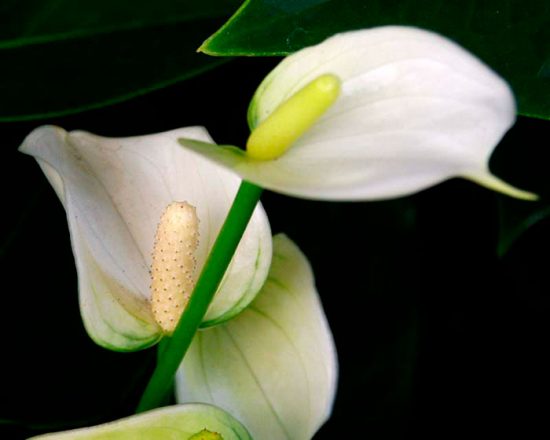

Watering features
Anthurium Andre loves regular abundant watering, but no frills: the upper soil layer needs to be given time to dry. Excess moisture can lead to decay of the rhizome, and its lack - the lack of flowering and wilting of the leaves. The optimal soil moistening regime is once every 4 days; irrigation water should be soft, at room temperature. In winter, the supply of moisture must be reduced to once a week, while preventing the earthen coma from drying out. An important factor in the successful development of a plant is high air humidity: 85-95%. To ensure it, it is recommended to install a humidifier near the container with the plant, or spray the air around the anthurium from a spray bottle twice a day. Moreover, the ingress of water on the leaves is undesirable, since a white lime deposit will remain on them. And this will somewhat spoil the appearance of such a beautiful indoor plant as anthurium.
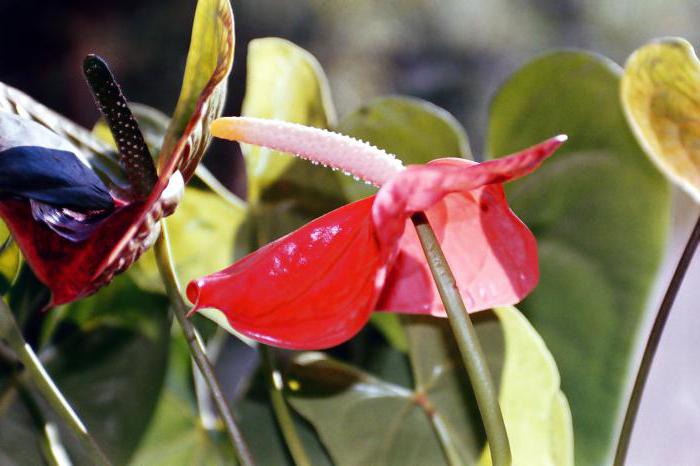

A photo of flowers conveys all the beauty of a tropical guest who has taken root in new conditions for him.
Anthurium substrate and transplant
The soil is prepared loose, light. Soil composition:
- Rough fiber sheet earth.
- Chopped moss.
- Light turf land.
In a ratio of 2: 1: 1. You can also take chopped tree bark or chopped coconut coir as a basis. With regular feeding, anthurium grows well in clean bark. A particularly moisture-absorbing and aerated substrate is as follows:
- Pumice (fraction 1–3 cm).
- Pine bark (fragments diameter 2–5 cm).
- Coarse peat
- Horse manure (well rotted).
Proportions: 2: 2: 1: 1. Pumice stone can be replaced with expanded clay. There is a successful experience of growing anthuriums in pure sphagnum moss and hydroponics.
Young plants are replanted annually. The procedure is performed only during the growth of the anthurium. The pot is selected in accordance with the root system. Too large a container increases the likelihood of root rot. The best material for a flowerpot is plastic, since in ceramics the soil temperature is usually below room temperature. A drainage layer is laid at the bottom. Anthurium is transplanted by transshipment without disturbing the earthen coma. The exception is if the plant was purchased, in this case, the entire substrate is replaced. When transplanting, the aerial roots are not buried, but covered with moss or coconut fiber.
Adult plants are transplanted as needed, no more than once every 3-4 years. The land is completely changed to a new, nutritious one. For several days after the event, the anthurium is not watered. Placed in a greenhouse, anthurium will more easily transfer a transplant.
Anthurium Andre - features of cultivation
The tropical representative belongs to a rather unpretentious plant, while standing out with beautiful waxy flowers, represented by inflorescences-cobs, wrapped in a blanket, against the background of glossy leaf plates of bright green color.
Among the features that a florist should take into account when growing a crop, there are:
- negative attitude to sudden changes in temperature conditions;
- the need for a high level of humidity and moderate watering;
- the need for regular feeding;
- lack of flowers if the rest period is not provided.
Reproduction of anthurium Andre Champion and pests
This is done vegetatively - by cuttings or offspring. The offshoots on the stems are well separated and already have small roots. Such young growth is already ready for planting in the ground. If the roots have not yet developed, then the shoot is placed in coarse sand or agroperlite, covered with a film on top. Do the same with cuttings.
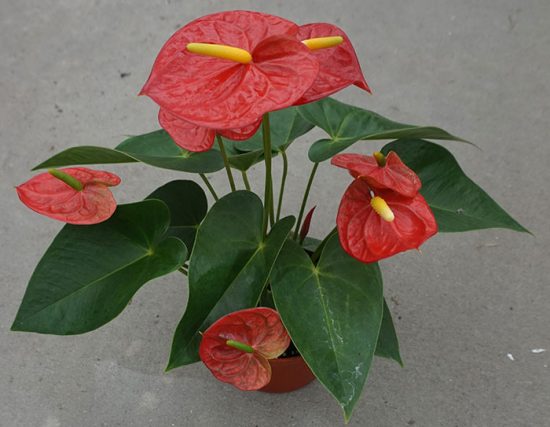

Old, overgrown plants can be rejuvenated.For this, the stem under the apex is covered with moss, tightly fixed, soon aerial roots will hatch there. Then the stem, together with the roots, is cut off and transferred to a separate cup.
Of the diseases in anthuriums, the most common are: various types of rot, anthracnose. The plant infects spider mites, scale insects, aphids. As a rule, all these problems are the result of improper care and maintenance of the flower. If the house contains a significant collection, then preventive spraying with fungicides is mandatory.
Due to its decorative and compact appearance, Anthurium Champion is suitable for small spaces. Feng Shui fans claim that this plant is able to redistribute energy, relieving a person of depression and a difficult state of mind.
How to transplant anthurium
Young plants are transplanted every spring in a larger diameter container. Adult specimens are transplanted at a time when the plant is already cramped in the old pot. The soil for anthurium should be light, nutritious, provide air access to the roots; the most suitable composition for orchids or bromeliads. Independently, soil for anthurium can be prepared from peat, leaf and coniferous soil. To maintain moisture, it is recommended to put sphagnum moss on top.
Botanical description of the plant
Anthurium belongs to perennial evergreen crops that migrated to us from the South American tropics. In the Aroid family, there are from 500 to 900 representatives, most of which are epiphytes, that is, plants similar to vines, for the reason that their aerial roots hang down.
Did you know? The culture is popularly called the flamingo flower.
André differs from other representatives of the family by leaves, the outlines of which resemble a heart, or have an oval-lanceolate shape, and their length reaches 30 cm. Such peculiar deciduous hearts are painted in a rich green color. Lovers of chic and gloss can choose a flowerpot with glossy leaves, and supporters of the classics - with matte ones.
But, the main advantage of Anthurium is its flowers, or rather their covers. Often, people do not believe that there is a living plant in front of them until they taste it by touch, because both its leaves and flowers are so elegant that they seem to be poured out of wax. The original flower itself has a conical shape (there are also clavate, spiral variants) and a light green or yellow color.
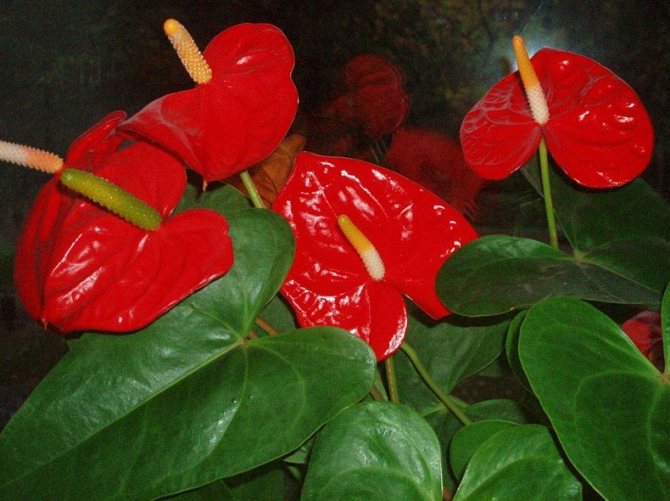

The ear-shaped inflorescence is surrounded by a heart-like bright veil that can delight the eye with bright red, pink, white, yellow, maroon, and even green shades. But, the most popular are the owners of red flower bedspreads. The lacquered surface may have a slightly bubbly or wrinkled structure.
In addition to a unique look, André flowers also have a seductive scent. But, sometimes it can have a fetid note. If you provide your tropical plant with enough sunlight, then it will delight you with its crystal flowers all year round. The flowering period of one flower is approximately one and a half months. Cut flowers can be used to form bright compositions and bouquets.
Did you know? Breeders have already managed to breed anthurium even with black flower bedspreads. You can also purchase a flowerpot, the flowers of which will be painted in 2 shades.
Anthurium even bears fruit. For this it is necessary to carry out pollination. The fact that the fruits are ripe is indicated by their yellow or orange color. Each fruit contains 2 seeds.
| Root system | air |
| Stem | average length - 35 cm (maximum - 1 m); shortened; thickness about 2 cm in diameter; dark green color |
| Leaf shape | oval-lanceolate, or heart-like |
| Leaf color | dark green, intense |
| Flower shape | the same as the shape of the leaves |
| Flower color | burgundy, red, pink, yellow, green shades |
| Fruit shape | rounded |
| Fruit color | possible variations of yellow, orange, pale pink, red, etc. |
| Fruit flavor | sweetish |
Varieties
The species-rich genus Aroid amazes with its diversity.
Did you know? The plant is usually given to men, as it symbolizes masculinity, passion, love, masculine happiness.
A small list of the brightest representatives of the Arturium Andre variety:
- Scherzer's Arturium in the circle of his "relatives" is considered a dwarf. The length of the Scherzer stem is only 15 cm, the thickness in diameter is 2 cm. Its pedicel can reach a length of 50 cm. It attracts attention with the original shape of the inflorescence: it resembles a spiral painted in a reddish-orange hue. The length of the spiral is 8 cm. It differs from Andre in the bright orange color of the bedspread, as well as in the sharpened shape of the leaves, which seem to be turned inside out. The length of the leaf ranges from 26 cm, and the width is 6 cm. The color, as in André, is deep green. The plant surprises with the simultaneous flowering of at least 8 flowers, and this extravaganza lasts up to 3 months. Now you can buy a Scherzer with a pink, red, green shade of bedspread, as well as a variety, the bedspread of which is mottled with two-color dots.
- Anthurium Crystal is an ornamental deciduous crop. Impressive is its huge velvety heart-shaped leaves, rich in green, which cut through contrasting silver veins. With age, the color of the leaves change, starting with bronze-purple shades, and ending with dark green. Compared to the large size of the leaves, the flowers of the Crystal variety can be described as nondescript, since they are too small - only 10 cm in length. But, on the other hand, their bedspreads are originally painted - they are purple.
- The closest relative of the Crystal variety is Great. It differs only in that its foliage is crossed not by silvery, but by white veins. And the flowers take on a light green or purple paint.
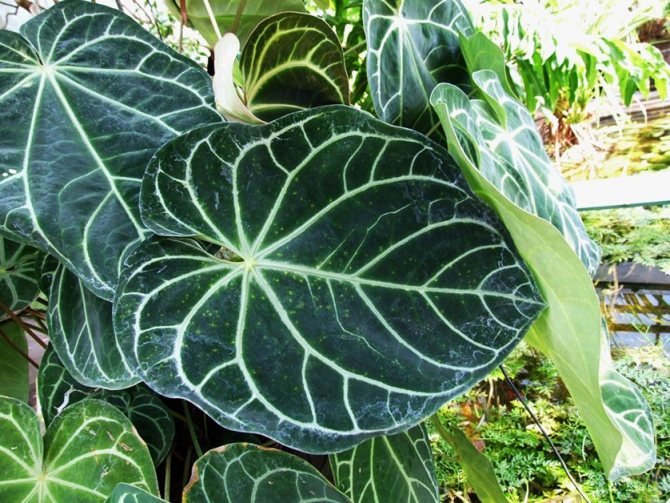

- Anthurium Andrianum Mix - a representative of the species that most resembles its wild-growing "relatives". Carrier of bright red inflorescences that delight the eye all year round.
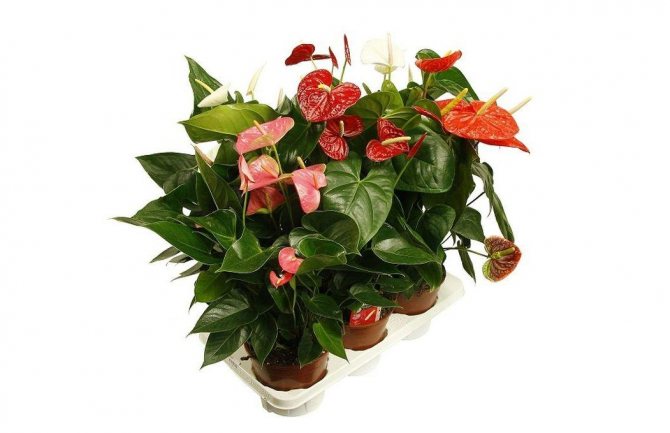

- Family of the Black Prince and the Black Queen - are considered chameleon varieties: they change the color of the bedspreads, starting with red and ending with brown-chocolate, almost black.
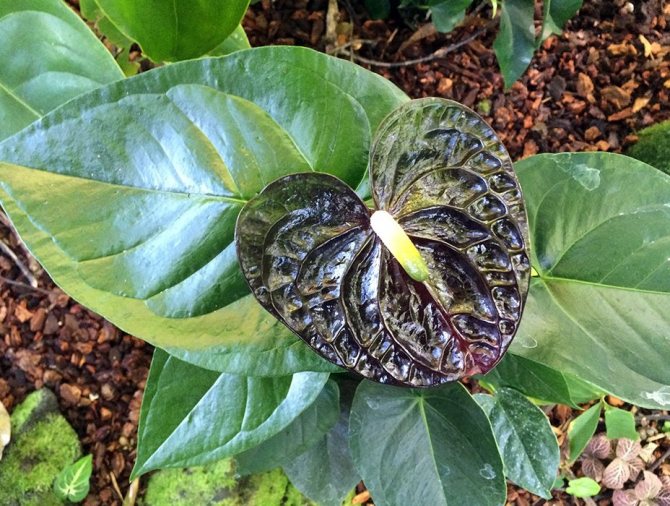

- Representatives of these cultures can be considered giants Baby Boomer varieties. Their growth reaches 90 cm. And large bright red inflorescences against the background of glossy green leaves cannot leave indifferent any connoisseur of beauty. True, flowering lasts only from June to September.
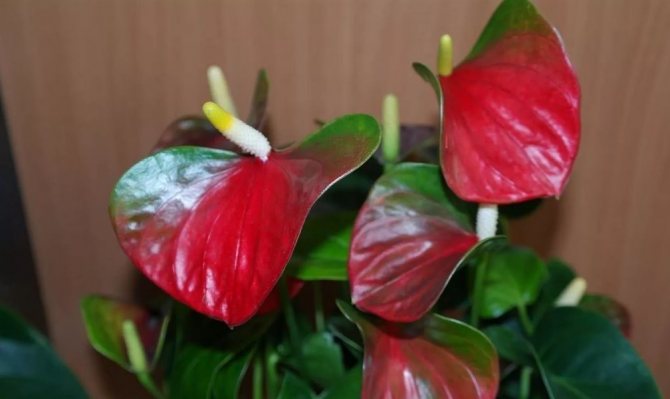

Description of Anthurium
Anthuriums Andre or Anthuriums Andrianum are evergreen plants of the Aroid family. There are many varieties of them, about 900.
They have leathery foliage, it comes in different shapes. Flowers are collected on the cob. The ear has a sheet-cover. The bedspread comes in different colors, has a heart-shaped shape
Attention! The plant requires rather careful care, it is difficult to grow it at home, some types of flower can be grown exclusively in heated greenhouses.
How to rejuvenate anthurium
Anthurium rejuvenation is carried out approximately in the fifth year of growth. In this case, the lower leaves begin to fall off, and the number and size of flowers is significantly reduced. To return the flower to its former attractiveness, you need to cut off the top of the trunk with 3 aerial roots. It is rooted in water or soil, covered with a jar or film to increase moisture. An old plant after such a procedure can release several "babies", which are also suitable for further cultivation. The main thing is to wait until they have their own root system and several full-fledged leaves.
Yellow Anthuriums and Orange varieties
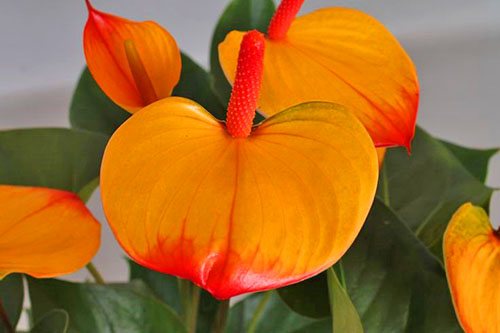

The Picasso cultivar group includes Orange Anthuriums like this one shown here, as well as plants with pink, purple, blue and white bracts.
According to the description, Picasso anthuriums are small plants suitable for indoor cultivation. A special charm to inflorescences is given by the color of the bedspread thickening to the tip and base, which makes the flower more voluminous and bright.
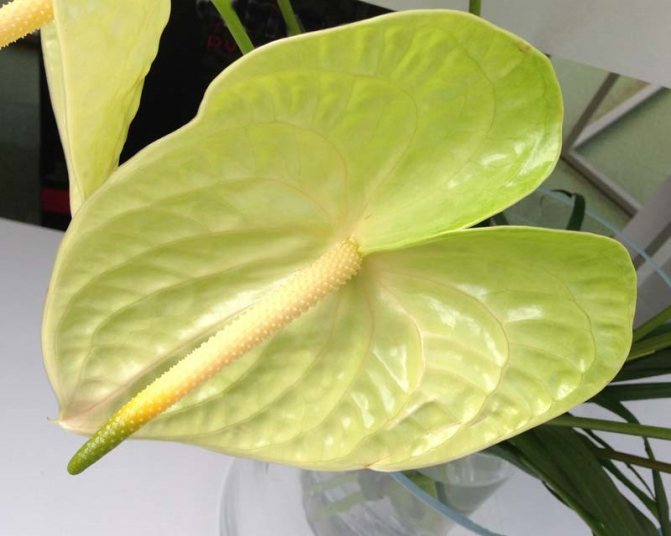

The yellow anthurium shown in the photo belongs to the Lemona variety. Such an inflorescence has a large cover of a delicate lemon shade and a white ear with a green tip.
Similar flowers
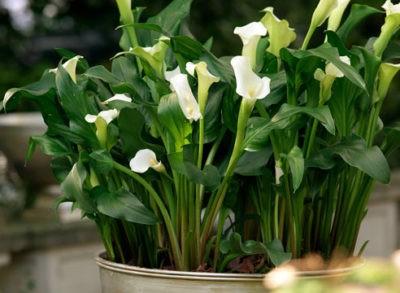

Spathiphyllum Cupido. The height of the flower is about half a meter. The leaves are large, rich green. The bedspread is wide, pointed, pale white.- Spathiphyllum Picasso. The height of the bush is up to 40 cm. The leaves are long, shiny, pointed. The bedspread is voluminous, variegated in color.
- Alokazia Klobuchkovaya. Leaves are dense, wide. The cover is fleshy, the ear is of medium length.
- Calla Swamp. The leaves are dark green, heart-shaped, smooth. The ear is oblong. The bedspread is flat, white.
- Calla Elliott. Differs in abundant flowering. The bedspread is bright yellow, long. The leaves are green with white splashes.
To grow a healthy and rich Andre anthurium bush, to achieve bright flowering, you should strictly adhere to the rules of care, observe the feeding regime and carry out timely rejuvenation of the plant.
If you find an error, please select a piece of text and press Ctrl + Enter.
Possible difficulties
The purchased flower is freed immediately from the store substrate, since it requires special watering and is not suitable for the home area. The most common disease is rotting of the roots and stems due to excess moisture and low temperatures.... Anthracosis - drying of leaf plates. Fungicides will help fight the disease. A small amount of calcium causes blackening of the ends of the leaves. The leaf part curls up in dry air and insufficient lighting.
To avoid possible difficulties and wilting of the plant, must adhere to the rules of care... Only an integrated approach will help you enjoy the lush bloom and colorful view.
We present the types and varieties of anthurium with photos and names. We describe the most popular varieties of "male happiness", name well-known varieties and group them by color (red, pink, blue, white, purple). We show photos of the most beautiful flowers.
What diseases do anthurium suffer from?
If the anthurium does not bloom at home, but only increases the green mass, the most likely reason is the presence of diseases and various kinds of pests. Excessive fertilization, improper care can also give this condition.
But it should be noted that when growing such a culture as anthurium at home: diseases and their treatment are those moments that least of all worry flower growers. After all, Aronium plants are toxic for most pests. Therefore, defeat is rare. Sometimes you can see an avocado scale insect or aphids. In the first case, it is enough to treat the flower with an ordinary soap solution. In the second, nicotine sulfate is used. They are sprayed with leaf plates, and after a day they are washed with clean water.
Usually, if the leaves of the anthurium dry at home or there is no flowering, the reason lies in the violation of the rules of care. For example, with poor irrigation, spots and dots appear on the leaves. The plates turn yellow and dry out. By adjusting the watering, the condition will soon improve. Inappropriate soil is also often reflected in the leaves. Especially if there is an excess of calcium. The leaves turn brown and curl.
Due to the high humidity, anthurium sometimes infects fungal infections. Gray rot manifests itself as a white bloom on the stems and greenery. Cured with Topsin and removal of the affected parts of the culture. Rarely, but still, culture and chlorosis are ill. In this case, the veins on the leaf remain green, and the rest turns yellow. To remedy the situation, you should feed the anthurium with mixtures that contain elements such as iron and magnesium.
White anthuriums
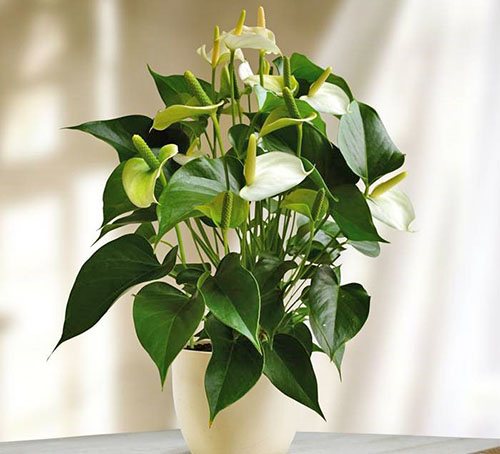

Anthurium variety White champion forms graceful inflorescences with an intricately twisted elongated bedspread and a straight, light lemon shade on the cob. As it matures, the ear changes color, becoming green. The bracts also turn green from the base.
Spectacular white anthurium White Heart strikes with the purity and freshness of the pointed heart-shaped bedspread and the bright pink color of the cob, unusual for this species.
Anthuriums in pastel colors
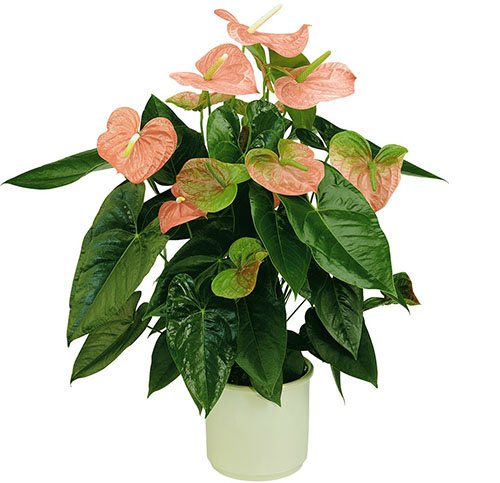

Blush pink, toasty varieties, as well as peach varieties of anthuriums are extremely highly valued and enjoy the attention of flower growers.
The pink Tennessee anthurium has an interesting feature, as it grows up, its covers and cobs change color. If the newly opened bracts are dominated by pure light pink tones, but over time their place is taken by green shades. The ear also turns from white to green.
Sharing the common varietal name Love anthuriums are a whole family of very attractive indoor plants with large inflorescences and bright glossy foliage. Anthurium variety Lady Love, for example, is distinguished by very bright pink bracts, the diameter of which reaches 17 cm. The cobs of the anthurium shown in the photo are even, pointed, of a light yellow shade.
But another anthurium of the Fantasy Love variety has a light pink ear, and in the color of the bedspread there are not only pink and green tones, but also white. Darker streaks are clearly visible.
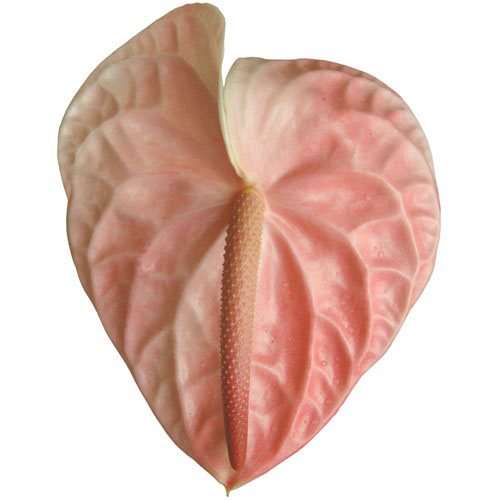

The bracts of the Blush anthuriums appear to be browned with a thin pink dusting. The ear in this inflorescence is also white-pink, thinning towards the tip.
Green Anthurium Midori


All inflorescences of green Midori anthurium from the moment of disclosure of the bracts have an even green color. Unlike other varieties of anthuriums, this varietal group also has green ears.
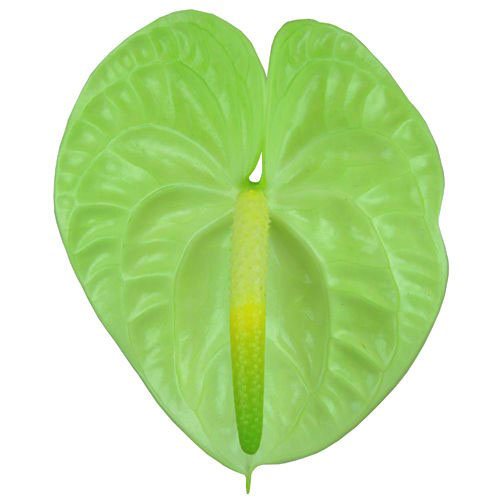

The exception is the Lime Anthurium varieties, which are similar to Midori, but differ in a lighter, yellowish tone of the bracts and a white-yellow ear.
Photo
Next, you will see a photo of Andre Anthurium:
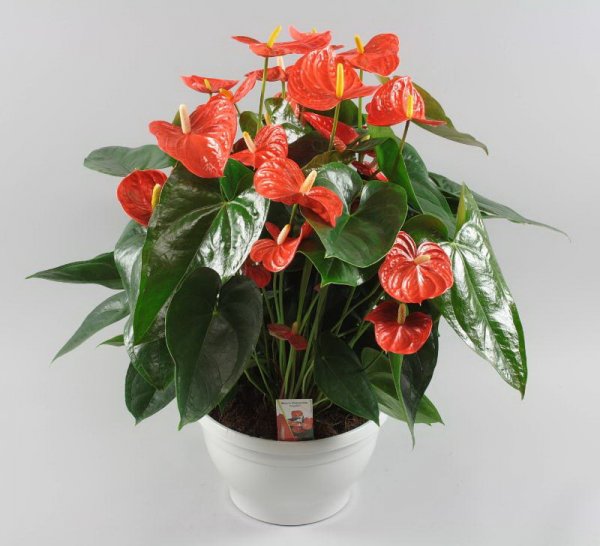

We offer you to see photos of such types of anthurium as Crystal and Scherzer. There you will also find a complete description and tips for caring for these plant varieties.
Red anthurium - a flower from an old legend
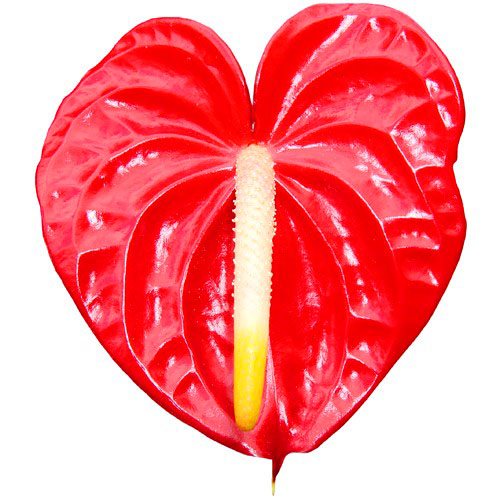

A bright glossy blanket and a yellow ear of many tiny flowers. This is how the classic anthurium looks like, the legend of the origin of which has been remembered for many centuries in South America.
The young beauty sacrificed her own life in the name of love and fidelity. Struck by such selflessness, the gods turned the unfortunate woman into a scarlet flower with a single petal in the shape of a girl's heart.
Red anthuriums are still considered classics today and are highly valued among flower growers.
Anthurium Dakota can rightfully be called the most famous and widespread variety. At the same time, the plant stands out not only for the rich color of the bedspread, but also for its size from 14 to 23 cm. A large, spectacular plant cannot be overlooked even in a very spacious room.
Anthurium's name comes from Anthos - flower and Oura - tail. But no less than the tail, the ear is like the long neck of a flamingo. But unlike flamingos, anthurium today can have more than just red or pink colors.
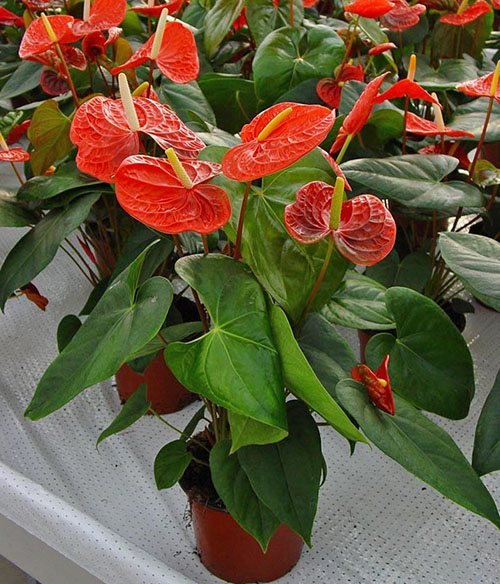

Anthurium inflorescences of the Minnesota variety stand out from a number of equally spectacular plants with bright scarlet bracts and cobs, changing the white color first to yellow, and then to green.
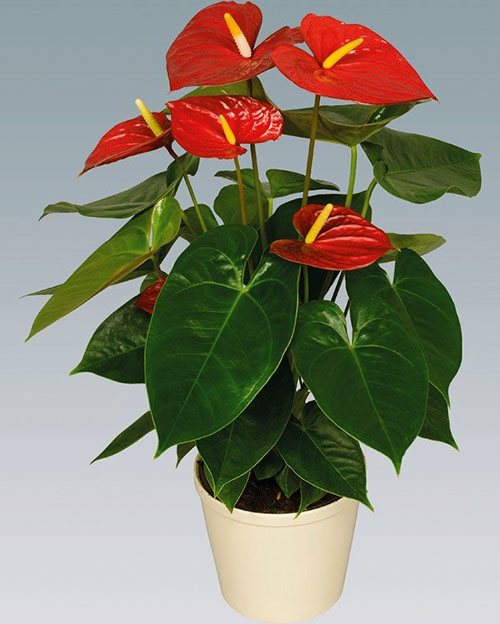

The group of Red anthuriums with a prevailing red veil in color is very large and diverse. Anthurium Edison also belongs to it, presented on store shelves not only with plants with red inflorescences, but also varieties blooming in pink tones.
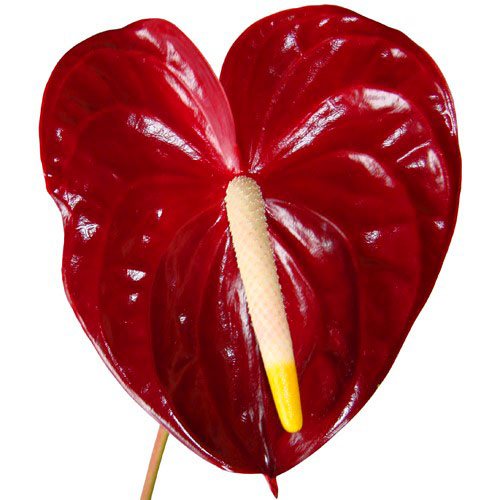

In addition to scarlet and classic red varieties, you can also find Dark Red Anthurium. Bracts of such anthuriums, as in the photo, come in all shades from raspberry, wine to burgundy, brown or almost black.
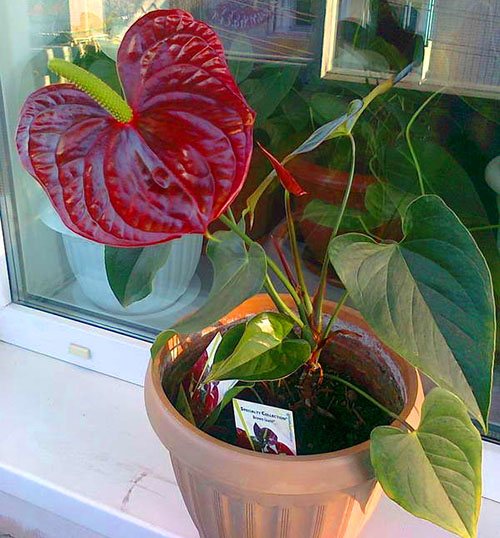

An example of brown anthurium is the Otazu Brown variety with a deep burgundy heart-shaped bedspread and a straight light green ear.
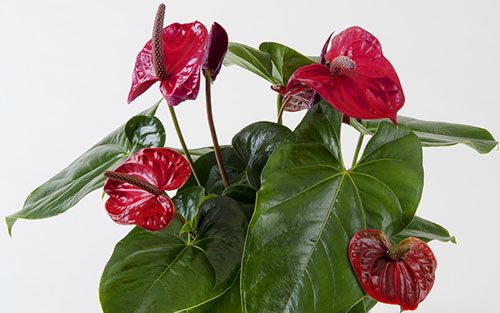

Anthurium varieties Utah willingly form large solemn inflorescences with a glossy textured blanket up to 14 cm in diameter. Anthurium cobs and bracts are violet or deep purple. At the same time, older inflorescences can be easily identified by the green tint at the base of the bedspread.
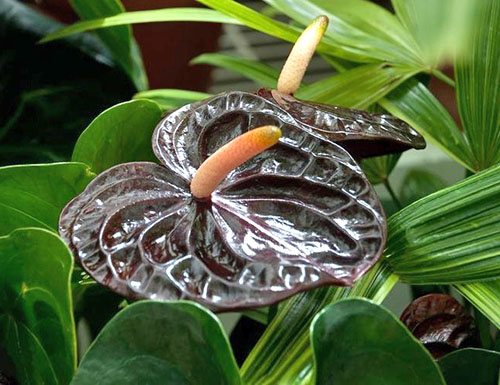

The luxurious Black Queen Anthurium appears even darker thanks to the light coloration of the cob. On the surface of the dense glossy bracts, all the veins stand out in relief, giving the inflorescence a fantastic look.
How to transplant anthurium (video)
Stimulation of budding and flowering requires special attention. To this end, anthuriums need to provide a cool two-month wintering at a temperature of 15 ° C. Subject to agricultural technology, the plant blooms from the last spring decade to the last summer days. For the best flowering, it is necessary to timely remove all fading inflorescences. If it is necessary to obtain seed material suitable for propagation of indoor ornamental culture, the plant is subjected to artificial pollination with a soft artistic brush.
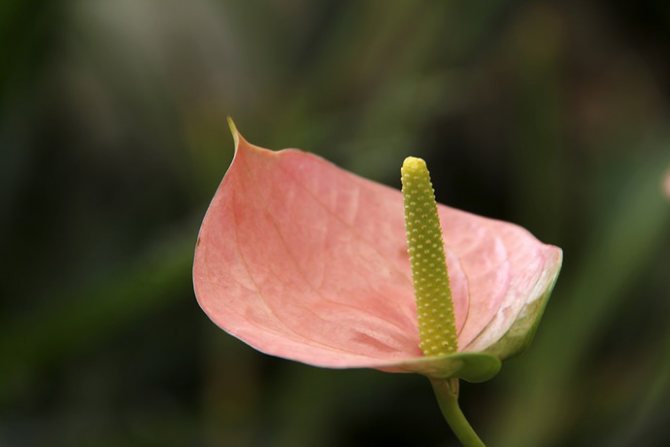

Transfer after purchase
Changing the microclimate and light source for anthuriums is a strong stress, and changing the land further complicates the adaptation process. Therefore, a temporary quarantine is arranged for the new inhabitant of the house: they are placed in a shaded corner near the window, preventing contact with other plants. After 2-3 weeks, you can determine the anthurium in a new soil and in a permanent place.
Important! If the condition of the flower after purchase raises concerns, then you need to remove it along with an earthen clod from the pot and examine the roots.
When signs of decay are detected, all old soil is washed off under a stream of water. The diseased parts are cut off with a knife and sprinkled with charcoal. After all the procedures, the plant is transplanted into a new pot and disinfected soil.
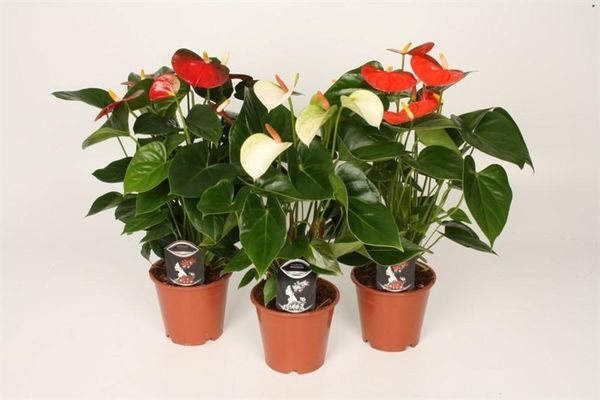

Reasons for the absence of flowering anthurium Addre
It is only natural that exotic plants such as Anthurium André are grown at home for great flowering. However, sometimes the growing season of a flower takes place without inflorescences pleasing to the eye, and then one should understand the reasons for an unpleasant surprise, which often lie in improper care:
- Moisturizing. It must be remembered that this species belongs to the inhabitants of tropical forests, and therefore requires high humidity around it. At the same time, the flower itself should not receive too much moisture through the soil.
- Air. The required temperature and a high degree of aeration of the root system must be ensured. To stimulate buds, it is recommended to place Anthurium in a cool place (about 16 degrees above zero). Avoid drafts around the flower.
- Top dressing. One of the reasons for the lack of inflorescences is a lack of nutrients. Fertilize the plant on time.
- Pests and diseases. The predictable result of a plant disease is its silent refusal to bloom. Treatment is urgently needed (see section on care).
- Excessive or insufficient light. Avoid exposing the flower to unscattered sunlight.
- Withered buds. For long-term flowering, Anthurium needs to ensure timely harvesting of already faded buds.
Rainbow palette
Anthuriums charmed florists not only with a variety of bizarre shapes, but also with a wide color palette. Scientists do not get tired of experimenting in obtaining more and more artificial varieties for greenhouse and home floriculture. Anthurium has an incredible number of bedspread colors, including even unique pieces with a combination of two or more colors. Anthuriums are found with yellow, pink-white, blue, pink bracts. Blue, purple, lilac, purple, and even black varieties look very original.Of all the variety of species, we also decided to pay special attention to anthurium with the strictest, white colors.

